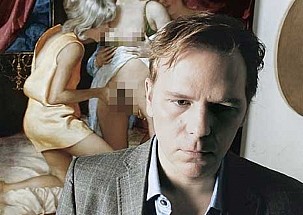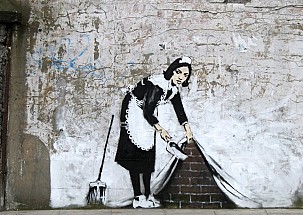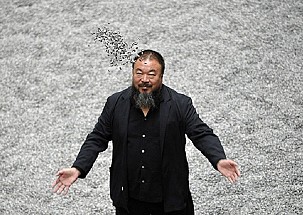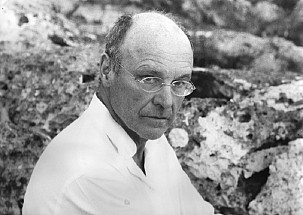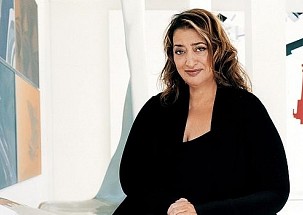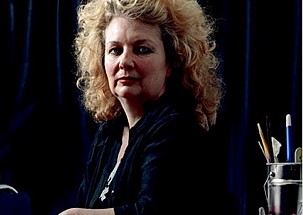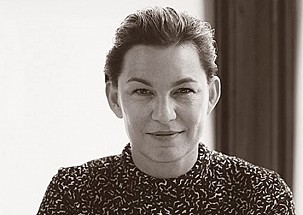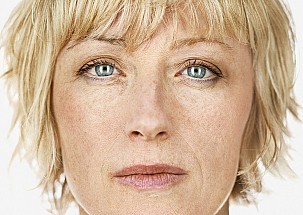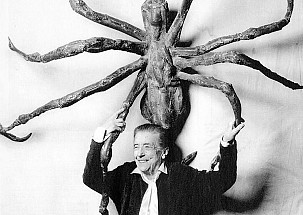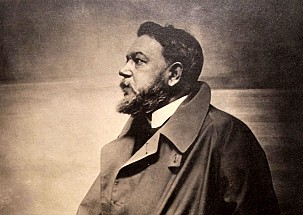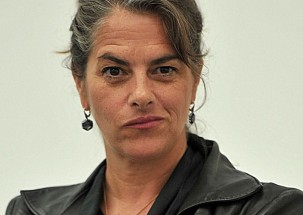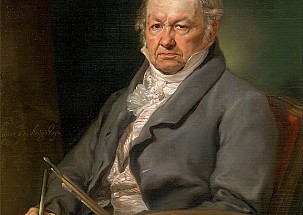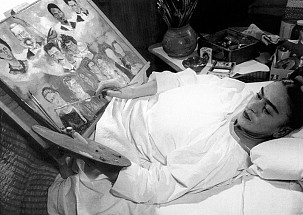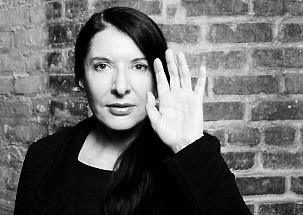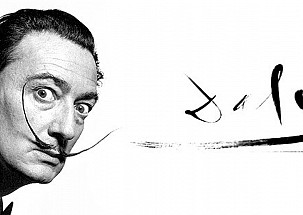- Details
- Written by Marina Valcárcel
It might seem these days that even the Thames is struggling to keep to its course given the exhibition currently making waves at the Tate Britain sitting on its banks. It tells the story of British art before and after Francis Bacon (1909-1992) and Lucian Freud (1922-2011), welling up from a hot spring of works by Stanley Spencer, Chaïm Soutine, David Bomberg, Walter Sickert and Giacometti, settling in the delta of thirty or so paintings by the eponymous rivals and ending with a small retrospective of contemporary painters such as Slade graduate Paula Rego and Jenny Saville. All too human: Bacon, Freud and a century of painting life is the title borrowed from Nietzche's book by Tate Britain for its exhibit bringing together 20th and 21st century British artists who sought a new way of capturing the physical and psychological essence of human beings through the medium of paint.
|
Author: Marina Valcárcel
Art Historian
|
 |
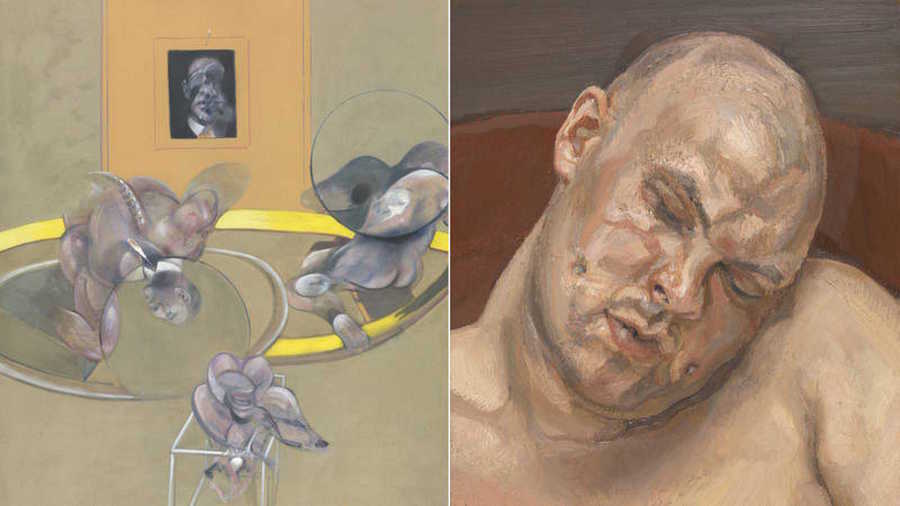
Francis Bacon Three Figures and Portrait, (1975) and Lucian Freud, Leigh Bowery (1991)
It might seem these days that even the Thames is struggling to keep to its course given the exhibition currently making waves at the Tate Britain sitting on its banks. It tells the story of British art before and after Francis Bacon (1909-1992) and Lucian Freud (1922-2011), welling up from a hot spring of works by Stanley Spencer, Chaïm Soutine, David Bomberg, Walter Sickert and Giacometti, settling in the delta of thirty or so paintings by the eponymous rivals and ending with a small retrospective of contemporary painters such as Slade graduate Paula Rego and Jenny Saville.
All too human: Bacon, Freud and a century of painting life is the title borrowed from Nietzche's book by Tate Britain for its exhibit bringing together 20th and 21st century British artists who sought a new way of capturing the physical and psychological essence of human beings through the medium of paint. After WWII, British painters made one of their greatest contributions to the art world by reinventing the European tradition of figurative painting. By 1950, Michael Andrews, Frank Auerbach, Freud, R.B. Kitaj, Leon Kosso and Bacon were banded together under the label "London School" at a time in the lives of this group of artists and friends when they all pledged allegiance to past artistic traditions and orthodoxy whilst sharing a rejection of the abstract.
But, how does one paint life? Is it possible to capture the human experience on canvas? These were the questions that concerned and fascinated the artists showcased here with Francis Bacon and Lucian Freud, trapped in their world of solitude and torment, as the centrepiece.

Jenny Saville, Reverse (2002-2003)
Two Lucian Freuds?
Until the 1960's, Freud appeared to be painting with a magnifying glass. In an anteroom, separate from the main gallery dedicated to his later work, is Girl with a White Dog (1950). Kitty Garman, his then wife, is depicted sitting with a dog leaning on her legs, her naked body wrapped in a yellow bathrobe left deliberately open to reveal her right breast, the left one covered and her hand cradling it as if feeling for a heartbeat. The detail with which Freud studies the various surfaces is reminiscent of the Flemish Primitives. Kitty's thick, wavy hair as compared to the dog's rough coat, from the fluffy pile of the towelling dressing gown to the tassles that braid its belt. Those were the years of Freud's fascination with Ingres so Kitty's gleaming gold wedding band could even be deemed a dedication to the French Neoclassisist.
Freud had always had an obsession with painting eyes. They seemed to him to be the source of presence and power. They could, and even moreso their movements, express everything from desire to hatred, trust to mistrust and whether they decide to look us back in the eye or not. Pupils and the enigma of their dilation on observing an object of interest or fear intrigued him. Kitty's sad eyes are like two pools full of glints and contained tears. The dog's eyes, however, are the ones that, as if a mirror in a van Eyck painting, reflect the window in Freud's studio.
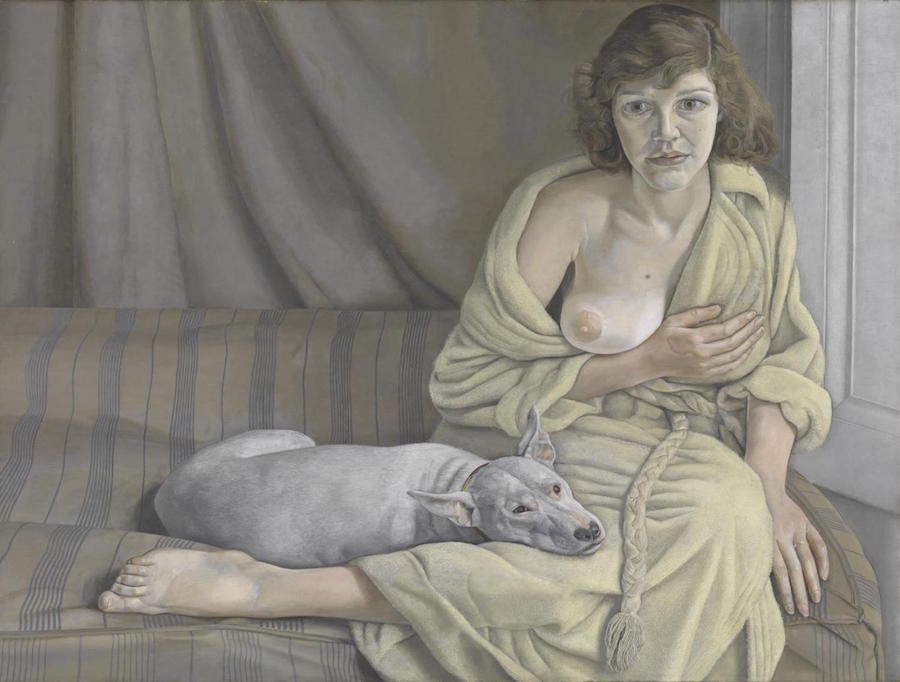
Lucian Freud, Girl with a White Dog (1950)
Towards the end of the 50's, Freud left drawing behind to focus on painting. He changed paintbrushes, replacing the fine, marten-hair ones with thicker, boar-bristle ones that facilitated his evolution towards those denser and more expressive brushstrokes characteristic of the later stages of his painting and displayed in the next room. There, man and beast return to centre stage in the form of David and Eli (2003-2004), his assistant and his dog exposed on a narrow bed. It is a striking nude study of epic, no-holds-barred proportions. The model in all his rawness, nothing more. It's as if Freud had invented a brand new style of nude and shone a violently bright light on it, subjecting that mysterious layer that is human skin to merciless analysis. Its thickness, its flaccidity and the inherently matte colours of pale skin, inseparable from a painfully lived reality.
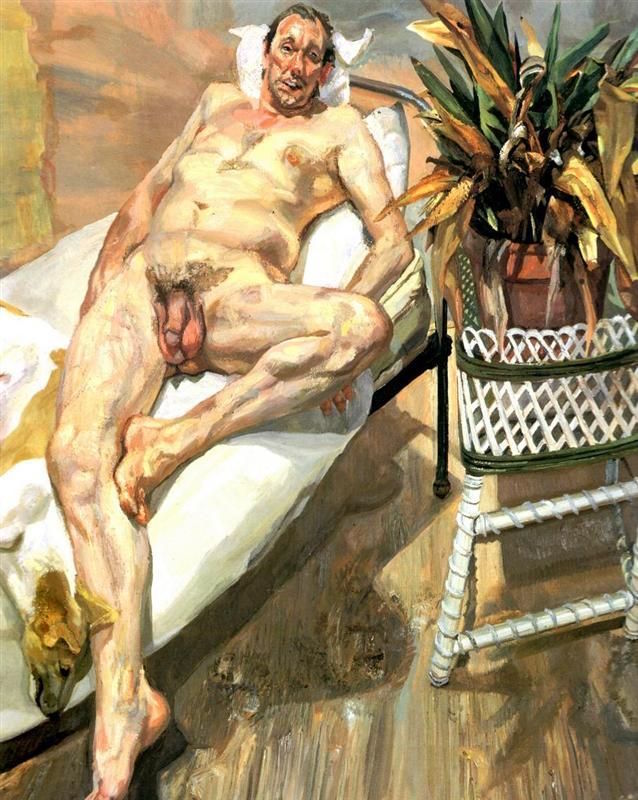
Lucian Freud, David and Eli (2003-2004)
Bacon and Freud: not a marriage made in heaven
In his book Man In The Blue Scarf, in which he relates his conversations with Freud while having his portrait painted, Martin Gayford recounts how, one day between poses, they were looking through a book on Van Gogh. Freud chose an Arles landscape saying: "Many people would say this is inspired by Japanese art but I would much rather this one than all Japanese landscapes of the 19th century put together. The most difficult thing is being able to draw well" and, mentioning Bacon: “Francis scribbled away constantly. His best work came solely from his own inspiration, I mean, when it wasn't based on drawing well."
Despite their differences, Bacon and Freud will be together forever in the minds of art historians. Gayford explains that the same thing happens with British artists as with the proverbial London bus delays ~ you wait for hours with no sign of one and then two arrive at the same time. In the 1880's, J.M.W. Turner and John Constable were seen as a pair and then there was nobody else until Bacon and Freud after the Second World War. Like Turner and Constable, Bacon and Freud made a bad marriage of artists, with as much dividing them as uniting them.
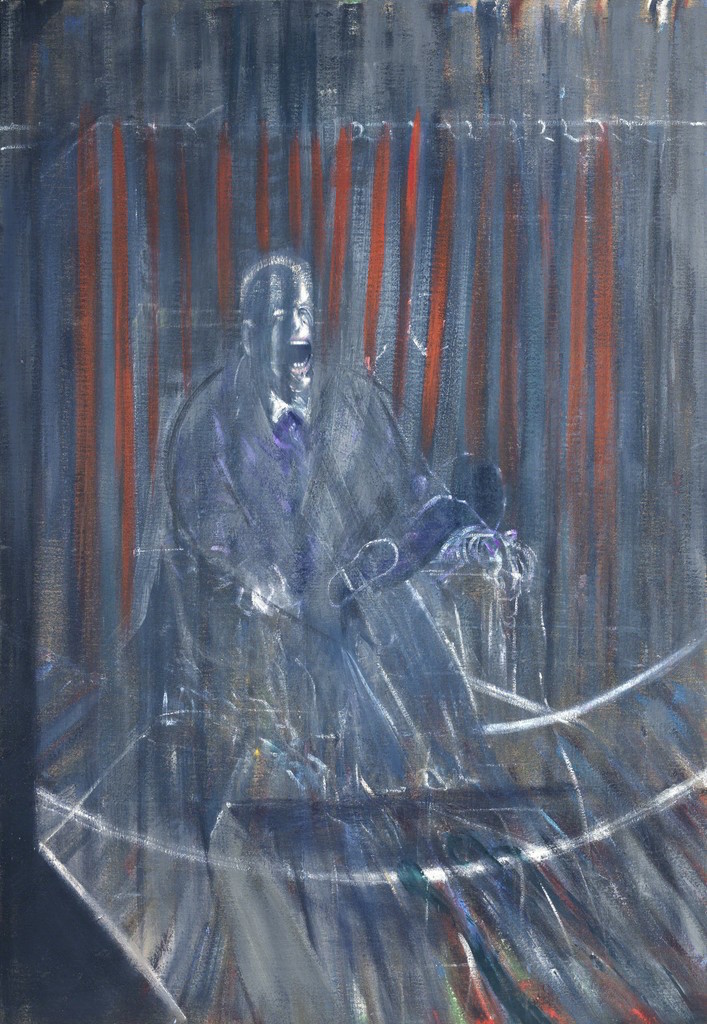
Francis Bacon, Study after Velázquez (1950)
Bacon, for his part, was obsessed with painting mouths: terrifying jaws at the end of eel-like necks that suck and swallow nightmares, lovers, pain, boardgames, alcohol, war and screams. It's life as a taut twine between birth, skinned flesh, violence, the great and the deep in human feeling and, ultimately, death. And, simultaneously, the most breathtaking beauty based on his innate taste for the serene monumentality of the Old Masters such as Rembrandt, Velázquez and Goya. But it was Picasso who really kickstarted his career, as did the literature of writers from Aeschylus to T.S. Eliot. This whole palimpsest comprising layer upon layer of Venetian colours, the oranges and pinks absorbed by black he daubed on the walls of his studio, transforming it into a giant 3-D palette, is what enabled him to do something that was only possible after the first Freudian generation ~ to paint trauma.
Rarely did he paint life models, prefering instead to work from photographs and movie stills. His painting came straight from his own imagination, capitalizing on every thought that entered his head "as if they were transparencies". He rejected the image as imitation. For him, it was all about that instantaneous piece of evidence transmitted directly to the brain and without the need for verbal intervention or "what happens in that instant to the nervous system". From there ,and not needing the logic of resemblance, his work would take off from his own aesthetic vision and from the beauty and energy of the strokes that, for him, represented a struggle and an intimate relationship between a painting and its painter.
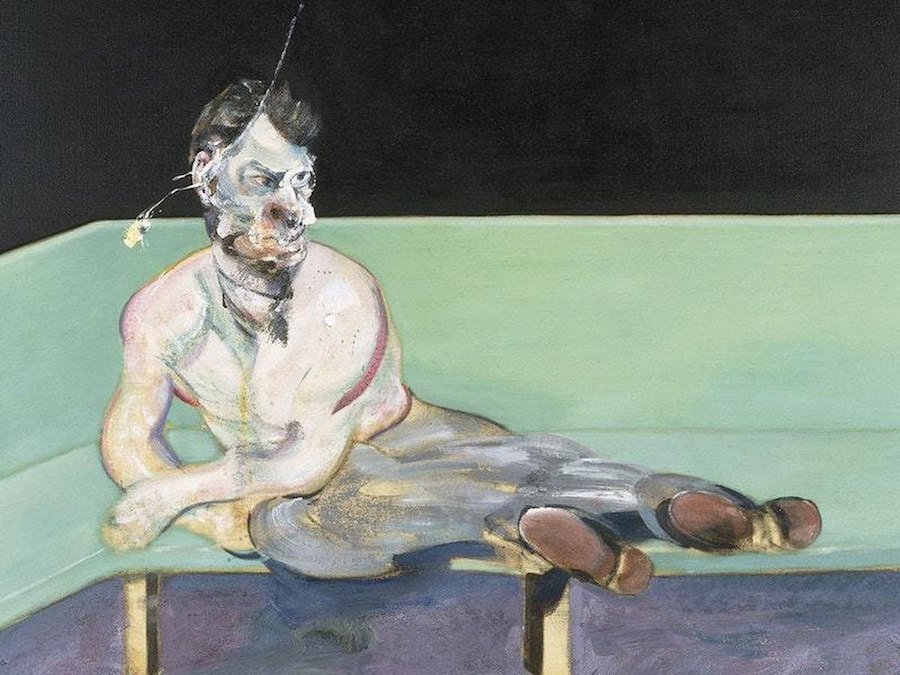
Francis Bacon, Study for Portrait of Lucian Freud (1964)
Standing in front of Bacon's Study after Velázquez (1950), we are reminded of this Irish-born artist's love of the Prado Museum in Madrid. His frequent visits from 1956 onwards are described by Manuela Mena as his eyes devouring the paintings of Velázquez: “He would study the brushstrokes, which is where it's all at, right up close and with deep concentration". He would go from painting to painting, "observing his subject much like someone examining the skin of their lover." The Prado exhibited Bacon in 2009 which, in its way, forever united him with Spanish painting of the 17th century.
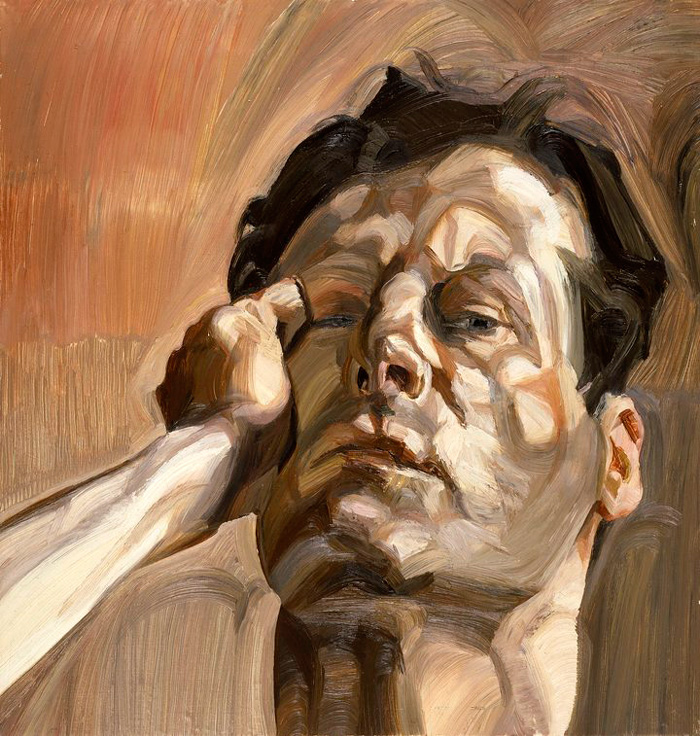
Lucian Freud, detail from Man's Head (Self Portrait 1), (1963)
Finally, the heat in this boxing ring of Tate Britain's creation rises as we approach the face-off between two canvases. In the red corner, Bacon's Study for a Portrait of Lucian Freud (1964), a painting unseen by the public since 1965, and in the blue corner, Freud's self-portrait Man's Head (1963). Freud painted Bacon twice. Bacon painted Freud over 40 times.

Francis Bacon (left) and Lucian Freud photographed by Harry Diamond, 1974
All too human: Bacon, Freud and a century of painting life
Tate Britain
Millbank, London
Curators: Elena Crippa and Laura Castagnini
Until 27 August 2018
(Translated from the Spanish by Shauna Devlin)
- Bacon versus Freud, a battle history - - Alejandra de Argos -
- Details
- Written by Marina Valcárcel
Vienna is this year commemorating the centenary of the deaths of Gustav Klimt, Egon Schiele, Otto Wagner and Koloman Moser. The celebrations kick off with a Schiele retrospective at the Leopold Museum: oils, watercolours, drawings and gouaches alongside photographs and poems. In all, over 200 breathtaking works of art divided up by theme. Egon Schiele died at the age of 28. The Leopold Museum in Vienna, which houses the largest collection of his work in the world, is now honouring the 100th anniversay of his death with an unforgettable exhibition. In one glass display case, there is a photograph of the artist, lying on his deathbed in a white shirt, his left arm bent lazily to support his head. He would look every bit the young man snoozing in the sun were it not for the wild flowers scattered over his body.
|
Author: Marina Valcárcel
Art Historian
|
 |
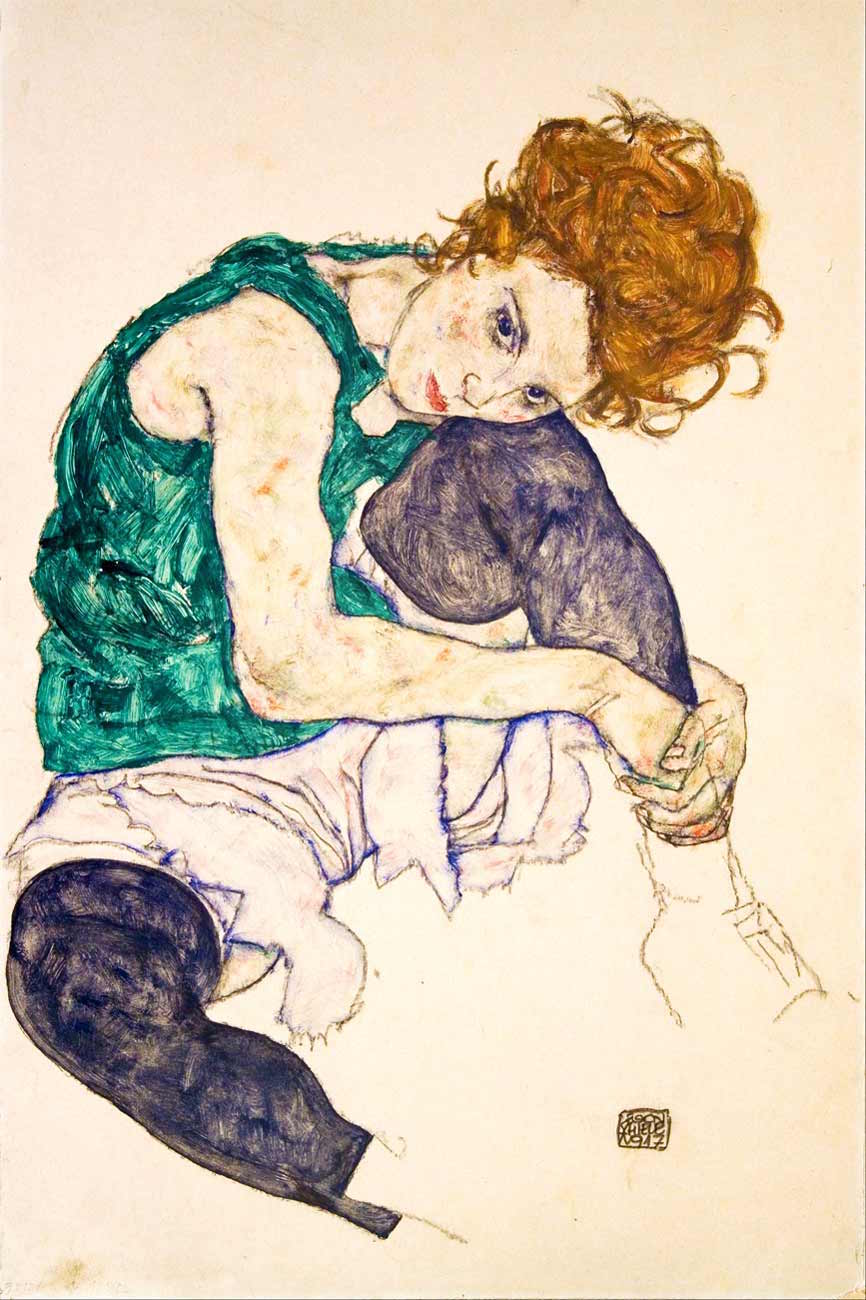
Egon Schiele, Seated Woman with Bent Knee, 1917. Narodni Gallery, Prague
Vienna is this year commemorating the centenary of the deaths of Gustav Klimt, Egon Schiele, Otto Wagner and Koloman Moser. The celebrations kick off with a Schiele retrospective at the Leopold Museum: oils, watercolours, drawings and gouaches alongside photographs and poems. In all, over 200 breathtaking works of art divided up by theme.
Egon Schiele died at the age of 28. The Leopold Museum in Vienna, which houses the largest collection of his work in the world, is now honouring the 100th anniversay of his death with an unforgettable exhibition. In one glass display case, there is a photograph of the artist, lying on his deathbed in a white shirt, his left arm bent lazily to support his head. He would look every bit the young man snoozing in the sun were it not for the wild flowers scattered over his body. Just a few hours earlier, Schiele had finished a sketch of his wife as he watched her from this bed. Edith, pregnant with their child, has her heavy head resting on a pillow, her eyelids drooping. None of them would live. Edith was to die of Spanish flu, whilst being painted by her husband, on the 18th of October 1918. Schiele, who had also already contracted the disease, would die three days later.
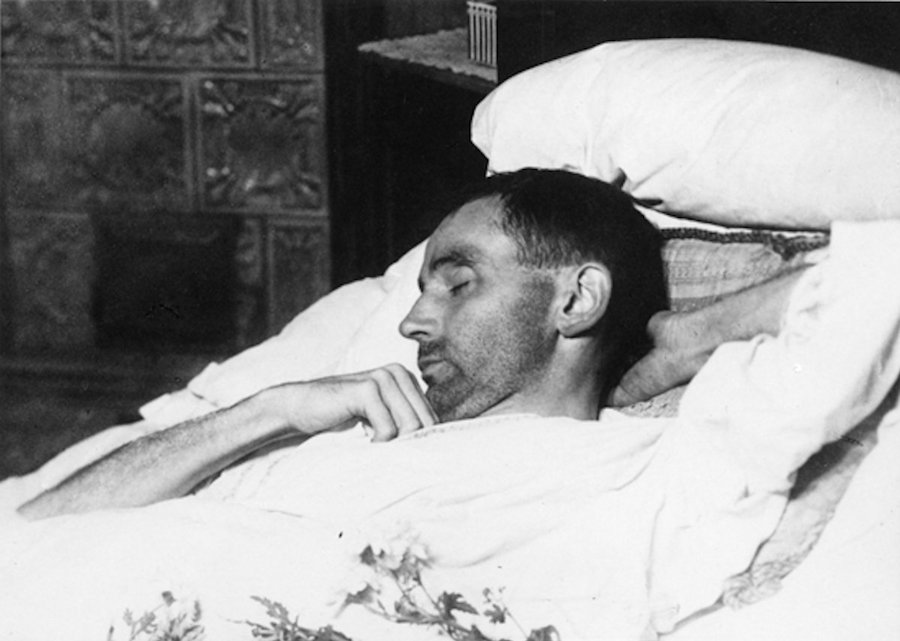
Marta Fein, Egon Schiele's Deathbed, 1918. Leopold Museum, Vienna
As a child, Schiele (born 1890) started out drawing the trains he watched in Tulln, a small city on the Danube, where his father was station master. He entered the Vienna Academy of Fine Arts at 16 and from then on, he remained inseparably tied to Austria's capital. Between 1898 and 1918, Vienna was both the finale and the prelude to many things. During the second half of the 19th century, this opulent hub of the Austro-Hungarian Empire saw the building of the Ring Road palaces while life pulsed and revolved around the operas and infectious waltzes of Johann Strauss II. At cafe tables all over the city, people read and wrote about themselves, much like characters out of a Joseph Roth novel, in the twilight of their empire. And still, slowly, Vienna was declining and falling all around them.
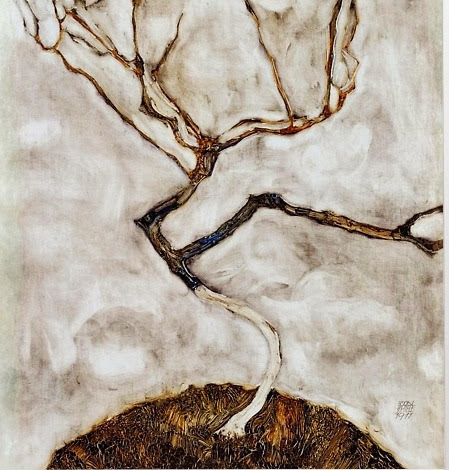
Egon Schiele, Small Tree In Autumn, 1911. Leopold Museum, Vienna
Sex and death
It was against this backdrop of an empire on the verge of collapse that the precursor to a new century was ushered in. It entailed an explosive surge in intellectual pursuit and artistic creativity throughout all fields. See the architecture of Otto Wagner, Josef Hoffmann and Adolf Loos. Hear Mahler's symphonies seemingly marking out the rhythm of a different spiritual beat. It was the time of writers like Kraus, Trakl and Schönberg and of philosophers like Wittgenstein. As regards painting, Gustav Klimt, the first president of the Secession movement, had started out as a conventional history painter but was now on the lookout for new horizons. Oskar Kokoschka and Egon Schiele were to represent the second generation of this artistic renovation and become the exponents of Austrian Expressionism.

Egon Schiele, Sitting Semi Nude With Blue Hairband, 1914. Leopold Museum, Vienna
The decadence of 1900's Vienna was an emotive catalyst that veered between two obsessions: sex and death. Old Austria was not just a void but a constancy that dissimulated the void. Nihilism made way for a new state of mind and a new bravado. Sigmund Freud discovered that pain created specific problems and conflicts that would not resolve themselves. He wrote The Interpretation Of Dreams and Studies On Hysteria which Schiele became obsessed with. Exploration of the "I" and sexual identity were all that interested him and this spilled over onto his canvasses.
Between 1910 and 1918, Schiele addressed various psychological topics. He left traditional portraiture behind, having pushed it to its absolute limits and, as Richard Avedon said, " he broke the mould and turned up the volume to scream pitch". Schiele's scream came from inside haggard, twisted, satanic bodies that terrified the society of his day. He was often his own model, gesticulating, mouthing words, his hair bristling and a menacing look in his eye, painting hands sharpened like spiders and which rarely depicted a thumb. He cut off his compositions to look almost mutilated, pushing the bodies of his subjects right into the corners of the canvas. His approach was radiacally "flat", like American art of the 1940's. Backgrounds didn't exist and bodies were suspended in the void, alone. Even the paper he used, from 1910 onwards, had something of the past-its-sell-by-date about it, a high concentration of lignin giving it a particular pale brown quality that could not withstand exposure to light. He sometimes outlined them with a white border, as if they had an aura around them. For Schiele, bodies emanated light: "I draw the light that comes from bodies."
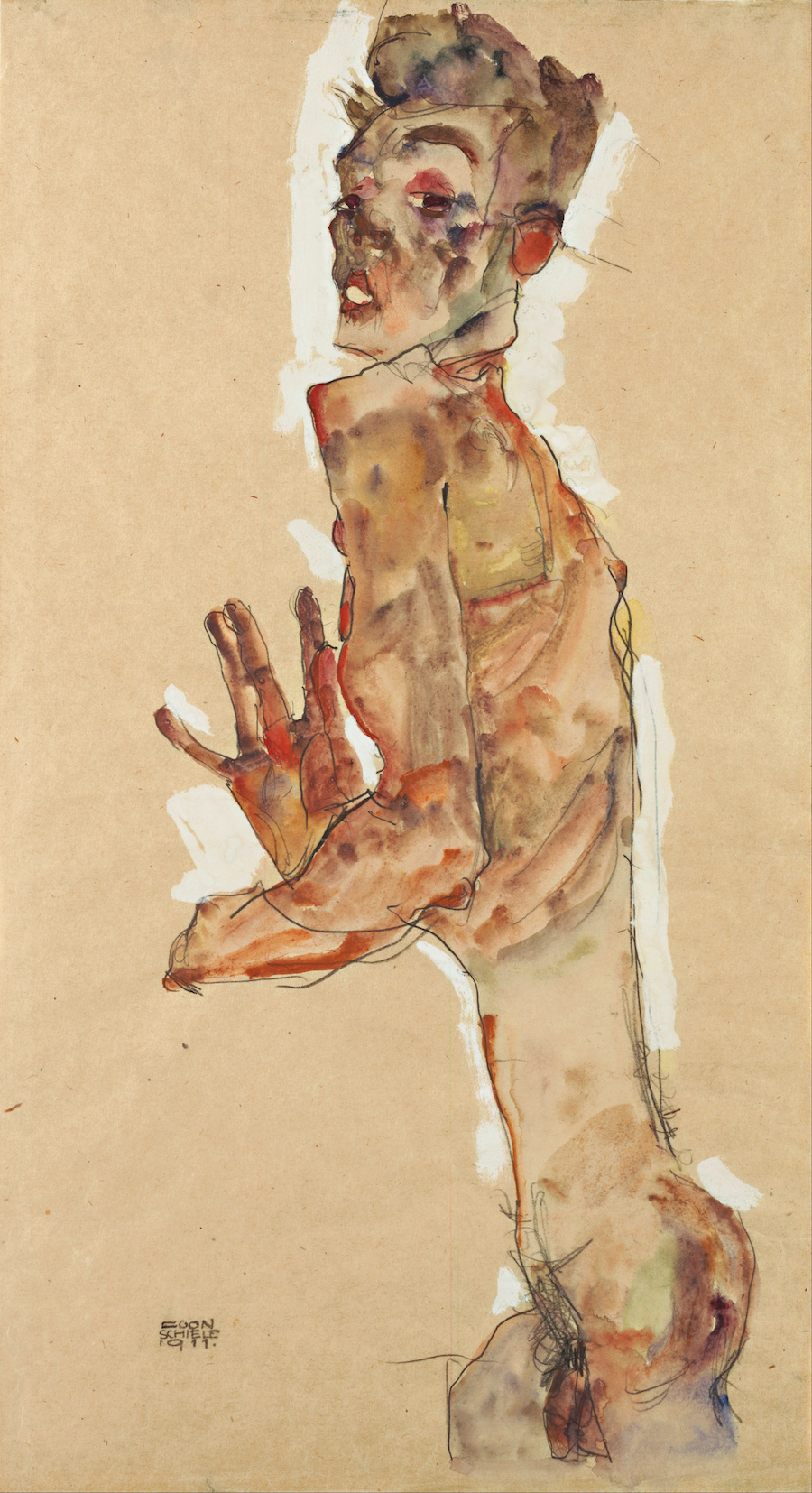
Egon Schiele, Self-portrait With Splayed Fingers, 1911. Leopold Museum, Vienna
Egon Schiele was all but forgotten during the 1930's but not so much so that the Nazi regime would neglect to include him on their list of degenerate artists. He was, however, rediscovered after WWII as a fundamental figure in modern art. His mutant, narcissistic persona would go on to attract other like-minded egos while later contemporary personalities such as James Dean and David Bowie would fall under his spell.
Egon Schiele, Self-portrait, 1912. Leopold Museum, Vienna
In the vast majority of his over 2000 drawings and 300 paintings, Schiele transforms the body - particularly the female one - into a chilling merchandise of desire. Skirts wide open, exposed genitals, prostitutes, his 14 year old sister, lesbian couples, priests, nuns, postures and bodies as if from an extermination camp. None of them has a real face. They are, rather, stunned masks with a look of the lost about them.

Egon Schiele, Lovemaking, 1915. Leopold Museum, Vienna
The aesthetics of the grotesque
One might say that Schiele was a master of the aesthetics of the grotesque. Up until then, in works such as Courbet's The Origin Of The World (1866) or Japanese prints, sex had never been treated in such a sordid manner. Why then do Schiele's paintings move us with their beauty? Why do his stray faces, enraptured gestures and anxious hands seem, at times, to possess the serenity of a Russian ballerina frozen mid-performance?

Egon Schiele, Preacher (Nude With Teal Shirt), 1913. Leopold Museum, Vienna.
The answer lies, arguably, in the virtuosity of Schiele's technique. Few artists have managed to convey so much with just one stroke, or even at times, a scribbled line. They ranged from sharp to caressing and from tense to delicate, whether hastily sketched or profoundly deliberate, broken or fluid. But above all, Schiele was prodigious in his use of colours, wholly independent of Nature's own. He used greens and purples, lilac, mauve and reds for human skin. His bodies looked ill but the colourways were sublime.

Albrecht Durer, Wing Of A European Roller, 1512. Albertina Museum, Vienna.
A short distance away from this exhibition in the Museums District is the Hofburg Palace with its still snow-covered gardens, Habsburg library and imperial steel filigree glasshouse and so we arrive at the Albertina Museum. In the rooms containing this collection, Albrecht Durer's watercolours rub shoulders on the walls with those of Schiele. 400 years may separate them but, regardless, they are both stitched from the same cloth of infinite blues, oranges or greens and the same mastery of line that edges each feather on the wing of Durer's birds or the body of Schiele's figures. In these days of strange and seemingly random censorship when photographs of prisoners are taken down at a Madrid art fair or posters for Schiele exhibitions are banned for obscenity in London, Cologne and Hamburg, it's well worth coming to Vienna. Sometimes, it takes raw, naked beauty to make sense of things. As Schiele himself wrote at the bottom of one of his watercolours, "I don't think there's such a thing as modern art. It's just art and it's eternal."

Egon Schiele, The Embrace (Lovers II), 1917. Belvedere Gallery, Vienna
EGON SCHIELE ~ The Jubilee Show
Leopold Museum
Museumsplatz 1, Vienna
Curator: Diethard Leopold
Until 4 November 2018
(Translated from the Spanish by Shauna Devlin)
- Egon Schiele, beauty and the chasm between - - Alejandra de Argos -
- Details
- Written by Marina Valcárcel
In the winter of 1910, Amedeo Modigliani was accompanied by Anna Akhmatova on his strolls around Paris where, together, they discovered the Louvre's Greek and Egyptian art collections, moulds from Angkor in the Trocadero's Indochinese pavillion and black masks brought from the Ivory Coast. Modigliani would later draw Akhmatova's Slavic silhouette with sparse outlines borrowing on the Egyption art he so wanted to immerse himself in. The sketch portrays her as solemn, serene, regal even, her posture only softened by a slight inclination of the head. Later still, this pair of young expat lovers in pre-WWII Paris, would recite Verlaine's poetry together duet-style. Akhmatova described their relationship thus in 1911: “We both read Mallarmé and Baudelaire.
|
Author: Marina Valcárcel
Art Historian
|
 |
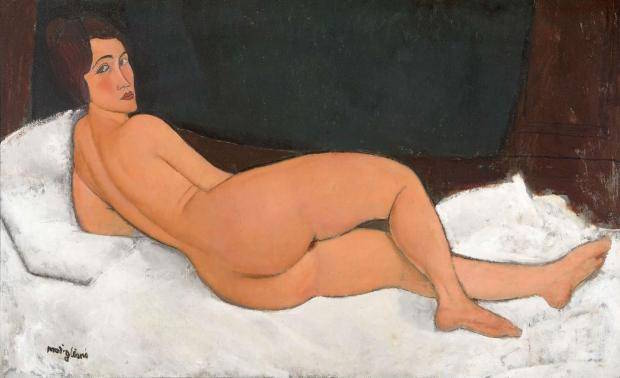
Nude, 1917
In the winter of 1910, Amedeo Modigliani was accompanied by Anna Akhmatova on his strolls around Paris where, together, they discovered the Louvre's Greek and Egyptian art collections, moulds from Angkor in the Trocadero's Indochinese pavillion and black masks brought from the Ivory Coast. Modigliani would later draw Akhmatova's Slavic silhouette with sparse outlines borrowing on the Egyption art he so wanted to immerse himself in. The sketch portrays her as solemn, serene, regal even, her posture only softened by a slight inclination of the head.
Later still, this pair of young expat lovers in pre-WWII Paris, would recite Verlaine's poetry together duet-style. Akhmatova described their relationship thus in 1911: “We both read Mallarmé and Baudelaire. But he never read me Dante because at that time I couldn't speak Italian”. She was 21 and just starting to write her very first poems in Russian. He was a 26 year old Bohemian artist and still a complete unknown. Modigliani is often remembered as an addict of alcohol and marijuana but, almost never, as a poetry or bookaholic.

Woman reclining on a bed (Akhmatova), 1911
Born in Livorno in 1884, he had been steeped, during his study years in Florence and Venice, in Classical Art and this immersion left an indelible mark on him. He arrived in Paris in 1906 and devoted what remained of his life to art. In Montmartre, he was just another immigrant along with the likes of Apollinaire, Picasso, Derain and Diego Rivera but, in his case, an Italian Jew suffering from tuberculosis and an exotic pariah amongst many other pariahs in that small, cosmopolitan republic of artists and writers. He may have been living in Paris but he was Italian through and through: in his dress (corduroy or velvet suits with knotted scarves), in his seduction techniques, in his understanding of beauty, in his wandering freely ... in his reading and reciting of Dante's Divine Comedy and Inferno until the day he died.
In the early years and similarly to other young geniuses like Picasso or Braque, he began painting in the style of Cézanne. But while Picasso and Braque would retain the Post-Impressionist's simplification in volumes, Modigliani, also heavily influenced by Toulouse-Lautrec and Whistler, focused on portraits but still made use of Cézanne's concept, brushstrokes and very nearly monochrome palette.

Head, 1911-1912
But it was in 1909 on meeting Brancusi that Modigliani left painting behind and between 1910 and 1914 he identified as a "sculptor". Together, he and Brancusi would scour the outskirts of Paris for materials to steal and bring back to the rented apartment they shared in Montparnasse. He began to chisel female heads directly from blocks of pilfered stone. He wanted to liberate sculpture from the dead end down which Rodin had lead him: so much modelling, so much clay. He thought chiselling should be done "live" the way the Ancient Greeks had done it, by breaking into a slab of stone in order to draw from it deities with African or Cambodian features. In the evenings, he would illuminate these heads with candles, turning his studio into a sort of primitive temple of the occult. In the Tate's current Retrospective, there is one room dedicated solely to his sculptures and it is a room that takes your breath away. In it, nine of his 29 sculpted heads rise like totem poles enclosed in their glass cases and arranged in a slantwise dance. The last time these heads were displayed together was at the 1912 Autumn Salon and Modigliani was then still alive. Lipchitz said of them: "He conceived them as a whole and set them up one in front of the other like the pipes of an organ in order that they produce exactly the music he wanted to convey."
The influence of non-Western sculpture in the Paris of Modigliani's day was radical. In 1906, Gaugin's Retrospective at the Autumn Salon shocked the Parisian avant-garde, especially the wood reliefs carved during his latter years in Polynesia, with their marked primitive and feral imprint. That same year, artists such as Derain, Vlaminck, Matisse and Picasso started to buy African art. All of this signified a turning point in Modigliani's career and, around 1914, he suddenly stopped sculpting. The dust particles released into the air he inhaled while chiselling were only exacerbating his disease and perhaps, also, it was occasioned by war being declared that year and his permanently dire financial straits.
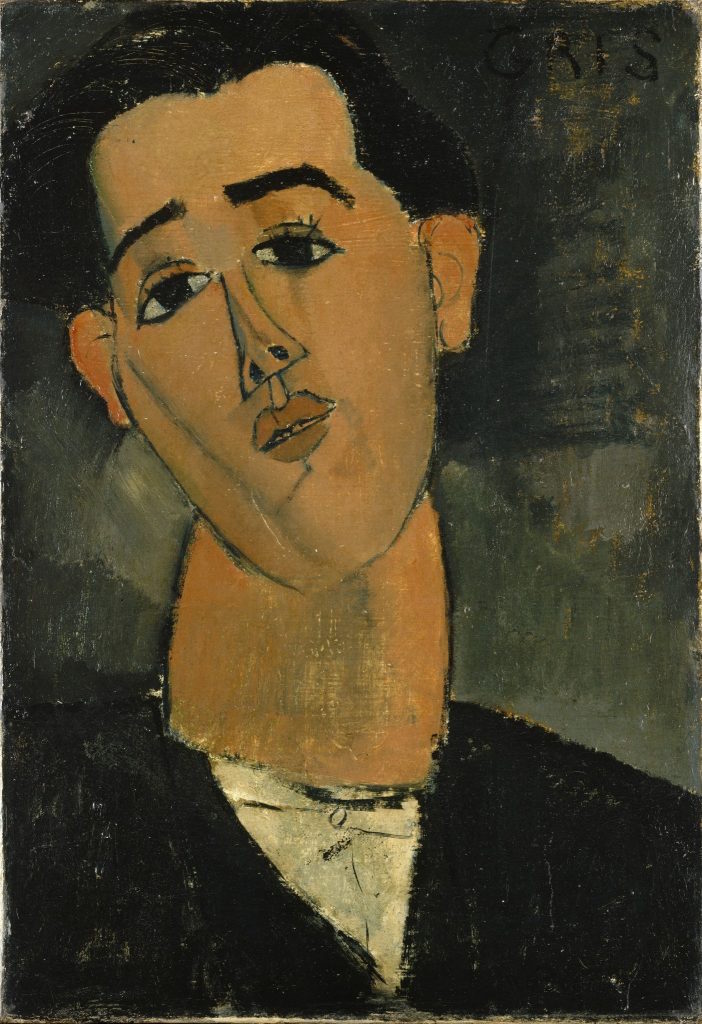
Juan Gris, 1915
Painter of artists' portraits
Between 1914 and 1920, the year of his death, Modigliano did only paintings and he did so profusely. In cafés such as La Rotonde, Le Dôme and La Cloiserie des Lilas he chose artists and writers as his models. This is also the time of his complex and serious relationship with the South African journalist Beatrice Hastings. Both were great readers, travellers and socialites. Both shared an addiction to alcohol - whiskey for her, red wine for him - and to hash. At the beginning of the 20th century, Montparnasse had become a ghetto for artists on the fringe of many things and beyond the reach, perhaps, even of the war that was wreaking profound changes on Parisian life. Choosing to be a painter in the artistic community of Paris was his way of trying to integrate his own lifestyle into his art.
This body of portraits, among which are those of Juan Gris, Celso Lagar, Picasso, Diego Rivera, Chaïm Soutine, Derain, Matisse, Cocteau and Max Jacob has many common denominators: subject matter tight to the frame, face-frontal poses and a fixed gaze. Nothing about them allows the spectator to escape the stare of those eyes except, perhaps, their recurrent lack of irises and pupils. Léopold Survage asked, on viewing the portrait that Modigliani had just finished of him: “Why did you only give me one eye?" Modigliano replied: “Because we look at the world with one eye and with the other, we look inside ourselves."
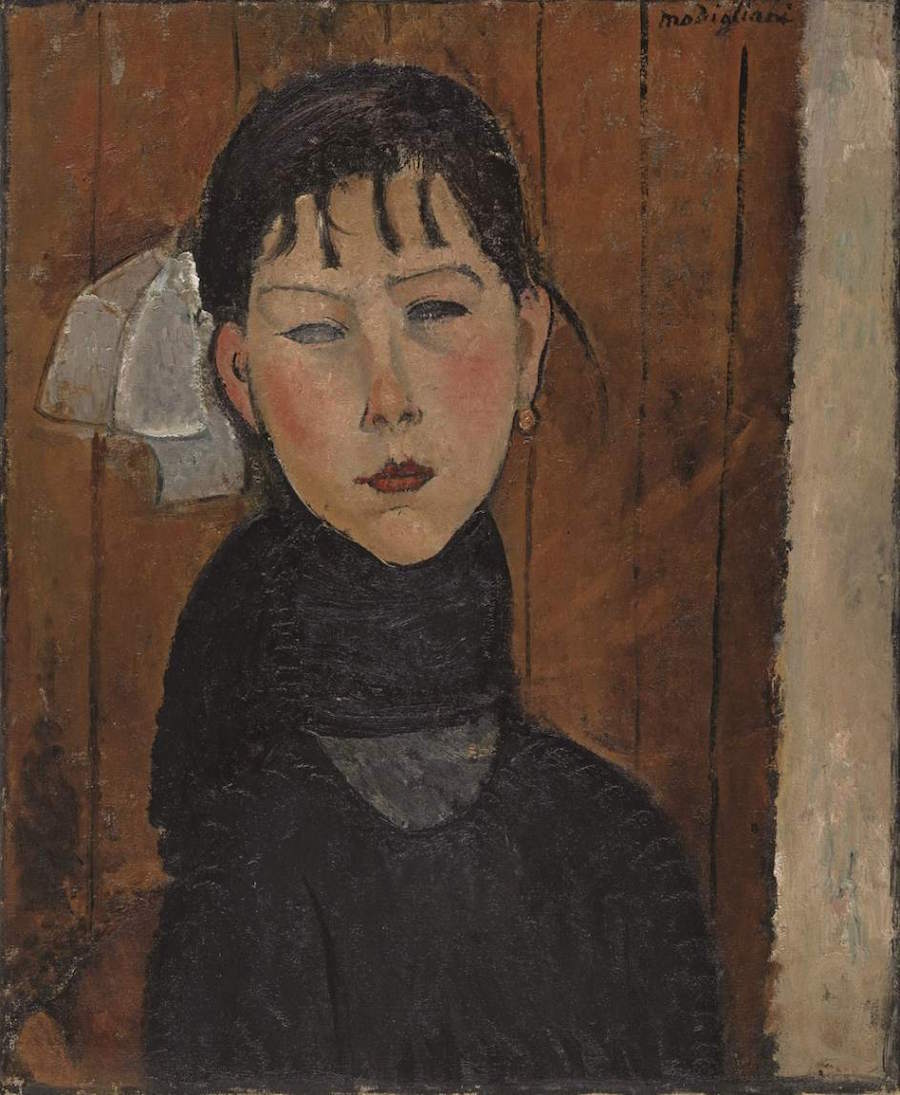
Marie, 1918
With Cubism now an emerging new art movement, Modigliani tried to create a "synthetic" image of the human being: outlined faces with the bridge of the nose and the eyebrows accentuated. The palette was dense but limited and the surfaces luminous. It was painting that came from some spiritual and intimate place and also from a commitment to integrating multicultural sources. Jean Cocteau summed it up perfectly: “First, everything took shape in his heart. The way he drew us around a table at La Rotonde, incessantly: the way he judged us, sensed us, loved us, discussed and argued with us. His drawing was a silent conversation. A dialogue between his sketch and us."
Scandalous nudes
Modigliani worked furiously, with no let-up, no holds barred. He painted by instinct, as dictated by his Italian genetic makeup and all whilst spitting out blood. Three years before his death, he painted his famous female nudes which were banned for indecency in 1917 - now a century ago - at the inauguration of the only solo exhibition of his work during his lifetime, at the Berthe Weill Gallery. They are, perhaps, the highlight of this Tate exhibit but why so? What produces this magnetic pull? Is it Modigliani's deep aesthetic imprint mixed with a blatant eagerness to provoke desire in the onlooker or was it the £113 million his "Reclining Nude" sold for at Christie's in 2015?
By now, Modigliani was no longer portraying a distant, ideal kind of beauty but a concrete woman: prostitutes, lovers or women who earned their living by posing for him. His models now were modern women with short haircuts, fashionable jewelery and makeup mimicking that of the cinema starlets of the day; women who look at the viewer and accuse him of voyeurism. The distance that existed in the canvases of yesteryear - from Giorgione to Manet's Olympia - disappears. Their bodies are firmly in the foreground, giving the impression of intimacy, as if they would allow us to touch them.
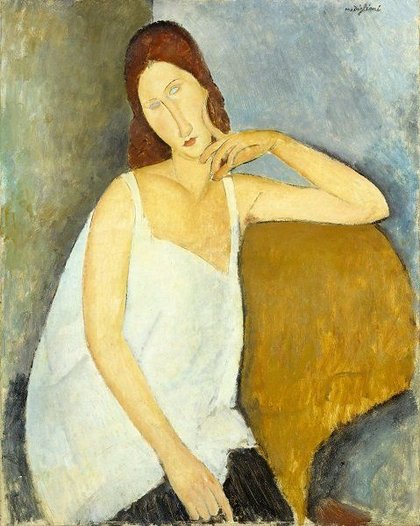
Jeannette Hébuterne, 1919
And after this sublime room, the exhibition closes with soft colours, pale light and the sweetest of subjects. These are the paintings of the time Modigliano spent in Nice and Paris with Jeanne Hébuterne, his common-law wife and young mother of his daughter, who was with him throughout his final demise. Shut away in their workshop, surrounded by sardine cans and bottles of wine, Jeanne painted Modigliani while he was dying. He was 35. She was 21. In the last room there is a portrait of Jeanne wearing an ample smock blouse flowing over her nearly full-term pregnancy. It has an air of Parmigianino's Madonna With The Long Neck but nothing about it hints that, just a few weeks later, she would throw herself and her unborn child off the balcony of her parents' apartment. She could not bear to go on after Modigliano's death, her lover with the christian name Amedeo from the House of Savoy and who, the previous day, had been buried with all the honours of a prince by an entourage of painters, writers, actors and musicians in Père-Lachaise cemetery in Paris.
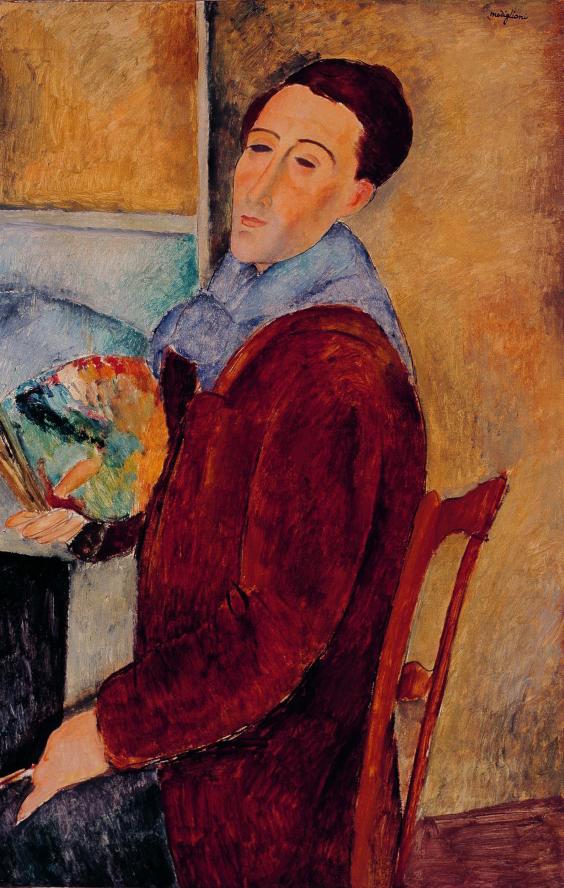
Self Portrait, 1919
Modigliani
Tate Modern
Curators: Emma Lewis and Nancy Ireson
Bankside, London
Until 2nd April 2018

Portrait of Jeanne Hébuterne being viewed by an exhibition visitor. Modigliani, Tate Gallery
(Translated from the Spanish by Shauna Devlin)
- Modigliani, a painter with one eye looking inwards - - Alejandra de Argos -
- Details
- Written by Marina Valcárcel
A few years ago, Bill Viola found himself with mental block as to how to portray an image of the Virgin Mary. This New York born artist, currently on exhibition in Bilbao, admitted: "I just couldn't figure it out. It flummoxed me ..." Despite his agnosticism and his knack of coming up with new ways to render other religious themes, the prospect of doing so with the Mother of God, and the weight of her infinite representations in art throughout history, shortcircuited the thinking of the artist who, nevertheless, did inaugurate his video-installation 'Mary' in the North Quire of St Paul's Cathedral, London in September 2016. Reflecting on Bill Viola has brought us to Lisbon's National Museum of Ancient Art, where the exhibition 'Madonna: Treasures of the Vatican Museums' reviews the iconography of Mary with over 70 works on display.
|
Author: Marina Valcárcel
Art Historian
|
 |
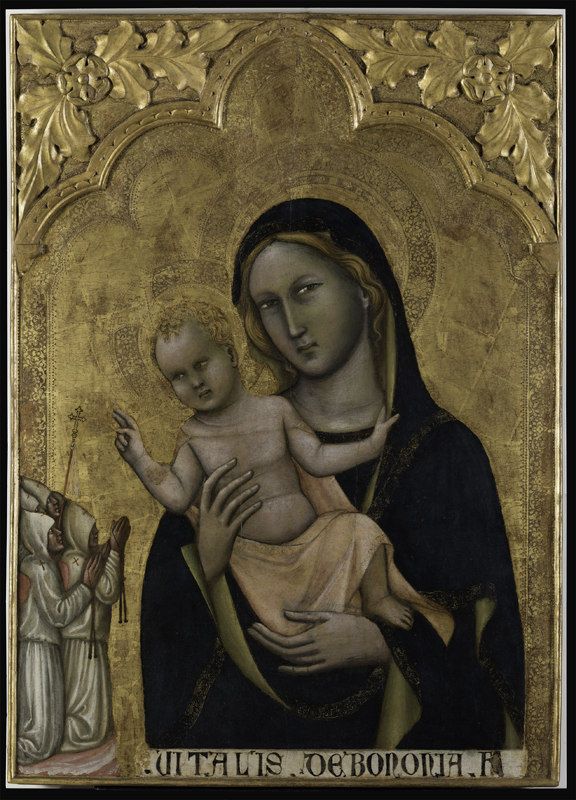
Vitale da Bologna, Virgin of the Flagellants (1350), Vatican Pinacoteca
A few years ago, Bill Viola found himself with mental block as to how to portray an image of the Virgin Mary. This New York born artist, currently on exhibition in Bilbao, admitted: "I just couldn't figure it out. It flummoxed me ..." Despite his agnosticism and his knack of coming up with new ways to render other religious themes, the prospect of doing so with the Mother of God, and the weight of her infinite representations in art throughout history, shortcircuited the thinking of the artist who, nevertheless, did inaugurate his video-installation 'Mary' in the North Quire of St Paul's Cathedral, London in September 2016.
Reflecting on Bill Viola has brought us to Lisbon's National Museum of Ancient Art, where the exhibition 'Madonna: Treasures of the Vatican Museums' reviews the iconography of Mary with over 70 works on display. Divided into 8 rooms, all painted blue in honour of Fra Angelico's skies, these paintings, sculptures, drawings and tapestries taken from various Vatican Museums allow us to travel in time from the 4th century to the 20th. We are accompanied by José Alberto Seabra Carvalho, the exhibit's curator, who stops us in the first room to point out two marble low reliefs from the tomb of a child found near St Peter's in Rome. It was one of the earliest burials in the old basilica, built over the tomb of the eponymous apostle, in the epoque of Constantine. Despite its antiquity, approximately dated the year 325, the Virgin Mary's iconography appears clearly and precisely, in an Epiphany scene.
Although the cult of Mary precedes the Council of Ephesus and even the Edict of Milan (313), the representations of Mary in the catacombs prove that her image did not become widespread until the Church's hierarchy was consolidated by Theodosius and Christianity became the official religion of the Roman Empire towards the end of the 4th century. In this work, Mary is already depicted seated on a throne, as were the empresses before her, and this iconography would later reappear during the Byzantine Empire and later still in Royal European courts. Nevertheless, the relation between maternity and government was known 2,000 years before Christ, when in ancient Egypt, Isis was depicted ruling with her son Orus.
The proliferation of icons of divine maternity was promoted by both emperors and the clergy alike. And to this cult was also added a calender: in the 7th century, Mary's four liturgical Solemnities had already been established and continue to this day.

Fra Angelico, Virgin and Child with Saints Dominic and Catherine of Alexandria (1435), Vatican Museums
Room 2 is a display of the dialogue between 14th century Sienese painting - with its Byzantian leftovers and Madonnas dressed in gold-leaf - and the 20th. Chagall's Crucifixion (1943) confirms the core axis from Duccio to Dalí, as regards the depiction of the Virgin Mary. “All of the collections of European art are inevitably great collections of Christian art: after classical antiquity, Christianity has since then been the patron of European culture", concluded Gabriele Finaldi in the catalogue The Image of Christ (2000).
As well as this affirmation and the massive bibliography compiled over centuries, we would do well to imagine the complexities faced by Christian artists on trying to represent Mary. Deciding who or what she looked like when no testimony as to her physical appearance exist; how to portray the episodes of her life; how to convey her suffering. These abstract concepts are difficult enough, almost impossible even, to figure out in words, let alone in image form.
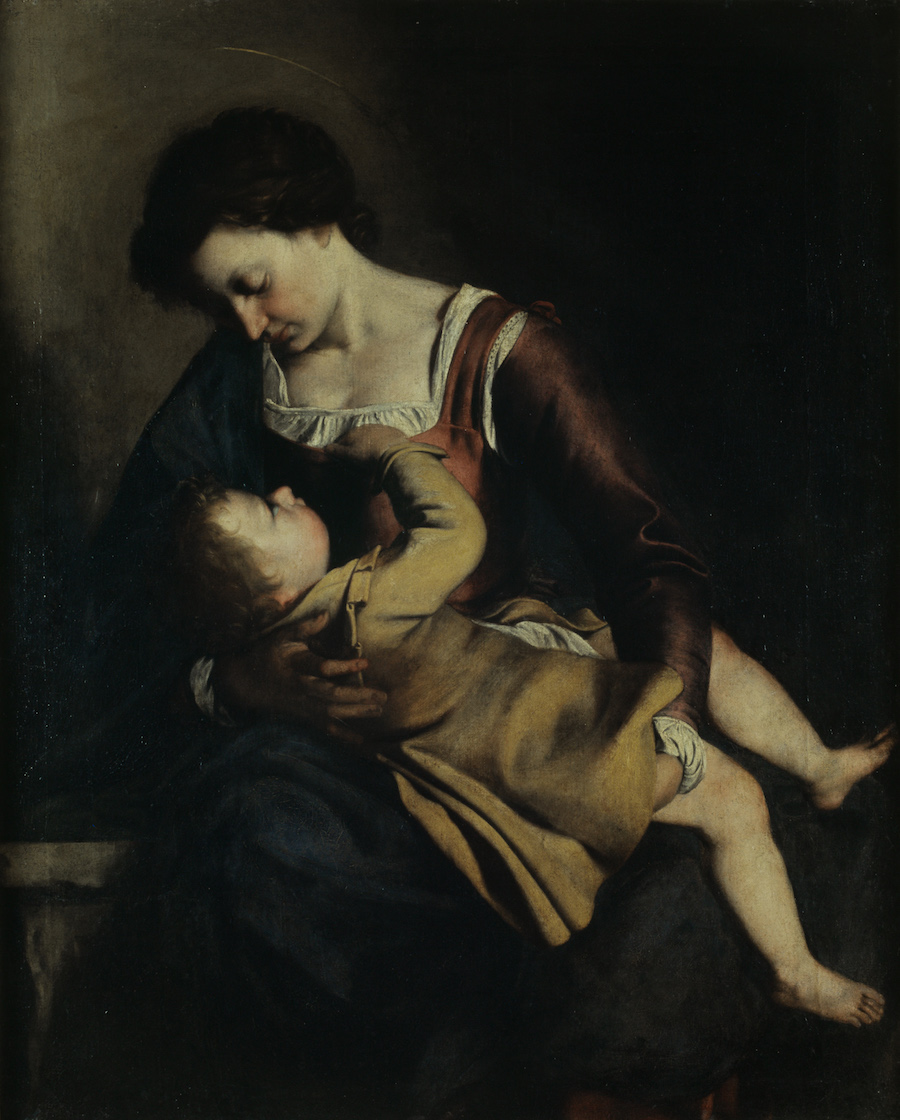
Orazio Gentileschi, Virgin With Child (1603), National Gallery of Ancient Art, Rome
There is a strange little Italian tablet in the exhibition entitled The Assumption of the Virgin, painted on black poplar wood around 1410 by the Siennese artist Taddeo di Bartolo. The scene takes place on Mount Zion where the apostles are crying over the flower-strewn tomb of Mary. Christ descends majestically from the clouds to kiss the hand of his mother and guide her on her journey's end to heaven. It's a wonderful, protective gesture full of tenderness and in sharp contrast to the syncretism of the rest of the scene. The most surprising thing, however, is the depiction of the physical separation happening between Mary's body and soul ~ the latter, behind her golden robe, painted as a monochrome silhouette with blue wings. What an odd and somewhat scary iconography. If the details surrounding these biblical events are unfamiliar to, say, non-Christian tourists viewing them, then what astonished reading might they give them? Moreover, according to the Apocryphal Gospels, Mary's immaculate body did not die but slept for three days before her ascent to heaven. And so we reflect again on the huge gaps in the teaching of our culture. What do the youth of Spain, untouched by these themes, think on seeing the Easter processions with weeping Virgin Mary statues paraded through the streets, their hearts pierced by swords. Or when, at the height of summer, all the shopping malls close in celebration of the Assumption of Our Lady. Perhaps it's similar to the frustration some of us feel when trying to decipher the reliefs on the walls of Angkor Wat or the Kufic caligraphy on the medallions at Hagia Sophia in Constantinople.

Rafael, Presentation In The Temple (1503), Predela del Retablo de los Oddi
The exhibition continues with great works by artists from Pinturicchio and Rafael to Van Dyck. Then to the Roman collection is added an extra treat ~ a final room, this time painted red, dedicated to some Italian works from Portuguese collections. Here are some very important pieces such as a Leonardo da Vinci drawing and an Adoration of the Magi by Tintoretto, of a similar calibre to those of the Scuola Grande di San Rocco.

Jacobo Tintoretto, Adoration of the Magi (1580-1590), Santo Tirso, Monastery of St Bento of Singeverga
Oriental Carpets And The Life Of The Virgin Mary
There is a secondary, though no less interesting, dimension to this exhibition. A singular look revisiting the world of thread- weaving: the textiles, fabrics, rugs, silks and tapestries that symbolise an exchange between East and West as well as between the decorative arts and their reflection in painting.
There are several fragments of 8th and 9th century silk brocade of, perhaps, Syrian origin on display. The link between these fabrics and their later Coptic versions signal an affinity between these five-thread silks and Near Eastern Christianity.
Nevertheless, it is the appearance of Oriental rugs in the Renaissance portrayals of the Virgin Mary or in scenes of her life that piques our interest here.

Gentile da Fabriano, Annunciation, (1425), Vatican Museums
Venice and its lakes were, in the 15th century, the gateway to the Orient. Its strong commercial ties with Constantinople prolonged an Eastern influence which lasted much longer there than in the rest of Italy. Also, luxury items such as hand-woven rugs (from Cairo and Damascus - controlled by the Mamelukes - Ottoman Turkey, Persia and India) were a great bargaining tool, 60 examples of which were gifted to Cardinal Wolsey in exchange for a license allowing Venetian merchants to export wine into England.
From the 13th century on, when Marco Polo declared those from Anatolia to be the world's finest, Oriental rugs were already in huge demand. So much so that they soon made their appearance in European painting. Their vivid colours and manifold, elaborate patterns were like a magnet for artists' paintbrushes. For a long time, and in the absence of any originals, these rugs were only seen through their depiction in paintings. Consequently, the better-known designs, with their medallions, arabesques and Boteh motifs were named after the artists who painted them: Lotto, Bellini, Crivelli, Membling and Holbein.
In his famous The Visitation (1504), Vittore Carpaccio sets the embrace between Mary and her cousin Elizabeth in an idealised version of his natal Venice, a Venice festooned for a Feast Day, its balconies and marble palaces draped with Oriental rugs. Only those rich enough to afford them displayed them as decoration outside their homes. A fact that, also, demonstrates the 'melting pot' that was Venice at the time: a city whose patron, St Mark, had been "stolen" from the Middle East; a city whose great Arsenal went by the Arabic name "dar sina'a" meaning 'House of Manufacture; and a city where, notably, Muslim prayer mats were painted on the ground beneath the feet of Christian divinities.

Vittore Carpaccio, Visitation (1504), Ca' d'Oro, Venice
We continue on our "thread trail" with more paintings. In his The Virgin of Humility (1435), Stefano di Giovanni - called Il Sassetta - paints his Madonna seated on a rug of the "Lotto" style and this fabric is clearly marking out a sacred space. Also, Gentile da Fabriano's Annunciation (1425) and Sano di Pietro's Scenes From The Life Of The Virgin (1438). At that time, with the exception of rare examples such as Jan van Eyck's The Arnolfini Portrait, these rugs were never placed on the floor since only the feet of a saint or a king could aspire to tread on them.

Stefano di Giovanni - called Il Sassetta - Virgin of Humility (1435), Vatican Museums
Now at the end of our double tour of the Madonnas on display, we make our way to the gardens of this 17th century palace on the river Tagus. On leaving, an image from the museum's permanent collection catches our eye, namely the imposing Saint Augustine by Piero della Francesca (1460-70). This bishop of the Church, with his austere, blank stare and his white gloved and bejewelled hands holding a crystal quartz crozier, wears a chasuble that is richly embroidered with scenes from the life of Mary. Again, a Nativity scene, the flight from Egypt ... and again, what on earth must the Vietnamese tourist beside us be thinking? His eyes are fixed on the Annunciation scene where a winged being holding a flower branch faces a kneeling woman whose abdomen is traversed by a beam of light? Wasn't it Marc Chagall, of Belarusian descent, who said: "The Bible is the greatest source of poetry of all time".
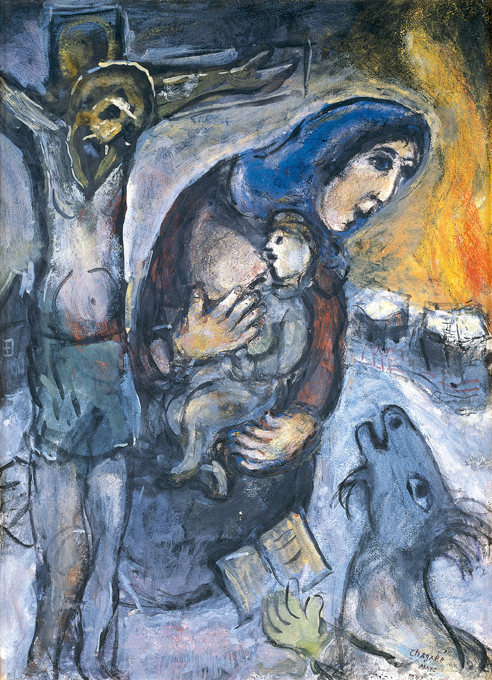
Marc Chagall, The Crucifix (Between God and the Devil), 1943, Vatican Museums
Madonna: Treasures of the Vatican Museums
National Museum of Ancient Art
Rua das Janelas Verdes 1249, Lisboa
Curators: José Alberto Seabra Carvalho & Alessandra Rodolfo
May - September 2017
(Translated from the Spanish by Shauna Devlin)
- Details
- Written by Marina Valcárcel
This is the story of a 21st century Iranian woman and a 19th century Spanish man meeting together in the Prado Museum, Madrid. The East/West frontier and the 200 years that separate them dissolve through the use of imagery, a means of expression first used by Goya and then by Farideh Lashai so as to denounce the dramas surrounding them: fratricidal wars, the cruelty of and between men, torture. Goya initiated the road towards modernity with a new but eternal message challenging injustice and Farideh, in re-envisioning his "Disasters of War", makes that message her own. Along with the recent anniversary celebration of Picasso's "Guernica" in Madrid, the works of both Goya and Farideh would seem to join their voices to his in a communal scream.
|
Author: Marina Valcárcel
Art Historian
|
 |

Detail: "And there's nothing to be done" from When I count, there are only you ... but when I look, there is only a shadow. Farideh Lashai. British Museum, London
This is the story of a 21st century Iranian woman and a 19th century Spanish man meeting together in the Prado Museum, Madrid. The East/West frontier and the 200 years that separate them dissolve through the use of imagery, a means of expression first used by Goya and then by Farideh Lashai so as to denounce the dramas surrounding them: fratricidal wars, the cruelty of and between men, torture. Goya initiated the road towards modernity with a new but eternal message challenging injustice and Farideh, in re-envisioning his "Disasters of War", makes that message her own. Along with the recent anniversary celebration of Picasso's "Guernica" in Madrid, the works of both Goya and Farideh would seem to join their voices to his in a communal scream. The lives of Goya y Farideh are entwined by several parallels: Goya lived through the Napoleonic invasion of Spain while Farideh was witness to events in modern Iranian history; from the arrival of Mohamed Mosaddeq, to that of Shah Reza Pahlevi, as well as the Iran - Iraq war. Both suffered voluntary exile and both sought refuge in art during illness and introspection at the end of their lives. This is, essentially, the story of an obsession ~ that of Farideh with the works of Goya.
Some of Chopin's "Nocturnes" should only ever be played senza tempo, allowing the melody, as if it were an anxious human voice unable to escape, to flow around us in waves that encircle and imbue us. Farideh Lashai's Nocturne emits from the piece it accompanies and lodges in the walls and floors of this little room in the Prado, forcing us to view Goya's "Black Paintings", the "Executions Of The 3rd Of May 1808" and "The Charge of the Mamelukes" on either side of it, in a completely different light. And it is here in this little room between them that Farideh Lashai has been invited to exhibit her "When I count, there are only you ... but when I look, there is only a shadow", an exhibition sponsored by the Friends of the Museum Foundation. The work, previously on show in the Museum of Ghant and continuing on later to the British Museum which is its current owner, will never again experience such an exceptional setting. Goya's "Black Paintings" will never leave Spain. For this reason, before leaving for Bilbao Fine Arts Museum, the Prado's director Miguel Zugaza thought it only proper for Farideh's work to be positioned here in amongst them, endowing them with a sense of the far-off and at the same time, embellishing them with a light different to that of the lantern illuminating the white shirt of the man about to be shot in "The 3rd Of May".
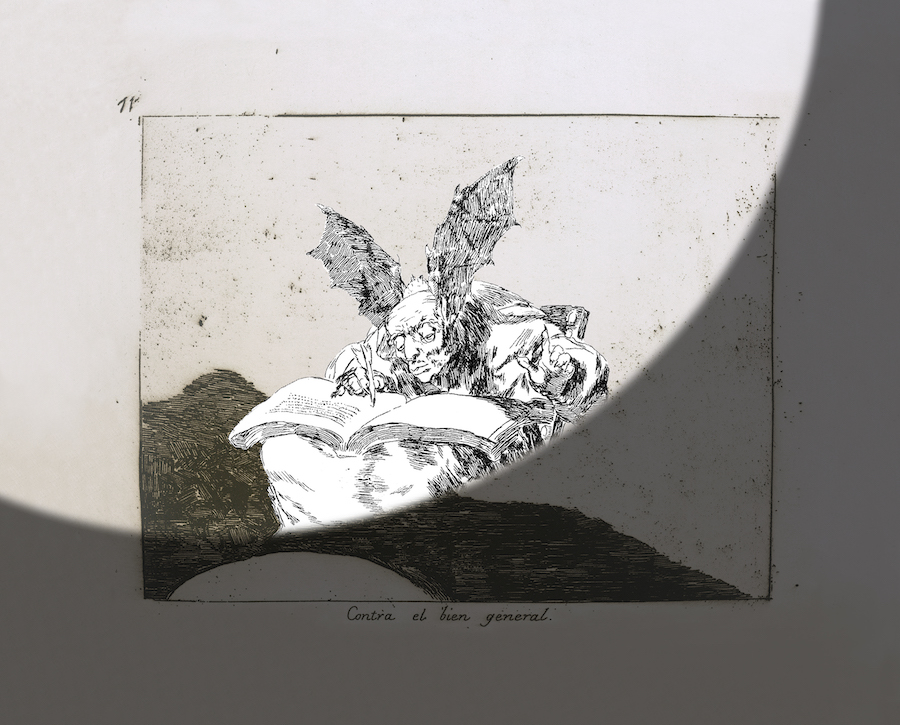
Detail: "Against the common good" from When I count, there are only you ... but when I look, there is only a shadow. Farideh Lashai. British Museum, London
"When I count ..." (2012-13), based on a T. S. Eliot poem, is the title of Farideh's latest work. Not at all surprising in that poetry is known as the bride of Persian literature, or that gardens were said to have grown on the Zagros mountains in the Iranian plateau, and lyrical poetry was a way of life for Farideh(1944-2013), one of Iran's most important contemporary artists. For this alchemist of sculpture, painting and stained glass design, writing was her backbone: "I lived in the city of Rasht until I was six. Those first few years left a strange mark on me. In the end, the place someone's born is like their mother: we're united by a primordial bond", she says in her autobiography "Shal Bamu". Whilst still a young woman, she travelled to Germany and studied at Frankfurt University where she found herself profoundly influenced by the works of Bertolt Brecht, at least six of whose books she translated into Farsi, as well as other works by Ginzburg. On her return to Tehran, she was arrested and imprisoned for three years in Qasr jail. Farideh knew no rules.
The exquisite text of the catalogue written by Ana Martínez de Aguilar, who curates the exhibition and who also translated the artist's autobiography from Farsi to Spanish, is entitled "I guard everything within myself". This phrase sums up the character and life of a nomadic woman who travelled to and from Persia from the rest of the world. In her book, written as a stream of consciousness, Farideh allows jumbled memories to flow from her childhood, surrounded by an earthly paradise of forest, sea and mountain ranges, through mystical Iranian poetry and on to political chaos. These leaps into the void mingle with her own memories, those of her mother and those of her grandmother. It's a matrilineal story in a patrilineal context that reflects personal and political life in the Iran of the 20th and early 21st centuries. All this pieced together with written words, painted words, layers of paint, and more words because as Farideh always said: "The joy that writing gave me was enough. To be able to capture a moment in words. To write meant images emerging like in a painting. In fact, I painted moments in time ... a dash of colour here followed by another there, or overlayed, in the same way that images follow one after the other from the written word. The synthesis of my work now turns out to be in the form of a collage."
This way of painting in layers came to fruition 7 years before her death when, already diagnosed with cancer, she began to use video-installations. This was her way of both avoiding the smell of oil paint whilst, at the same time, formulating a more complete message: to a still canvas she added movement, music and narration.

Detail: "Impossible to know why" from When I count, there are only you ... but when I look, there is only a shadow. Farideh Lashai. British Museum, London
For "When I count ...", Farideh takes Goya's "Disasters of War" series and manipulates it by removing every character from every scene. Men, women and children disappear, leaving only empty scenery, as in "A heap of broken images, where the sun beats" from Eliot's "The Waste Land". The original prints are no longer recognisable. They are now something else, something transformed into what could be the nondescript background to any other scene of desolation. There only remain ruins, scorched trees and lonely hills. It was Bertolt Brecht who first remarked on Goya's empty landscapes and this resonated strongly with Farideh who returned to the theme when, in the very last days of her life, she sees photographs and film of the outbreak of the Arab Spring.
Farideh scanned the figures and transferred them to digital film. The new photogravures are arranged in a rectangular pattern comprising 80 of the 82 prints from Goya's original series. The empty landscapes come to life as a moving beam of light, much like a theatre spotlight, is projected over each "Disaster", adding in the figures and animating them for a couple of seconds. The effect is magical and the influence, once again, of Brecht is palpable, as is that of Chinese and Iranian theatre, albeit from further away.
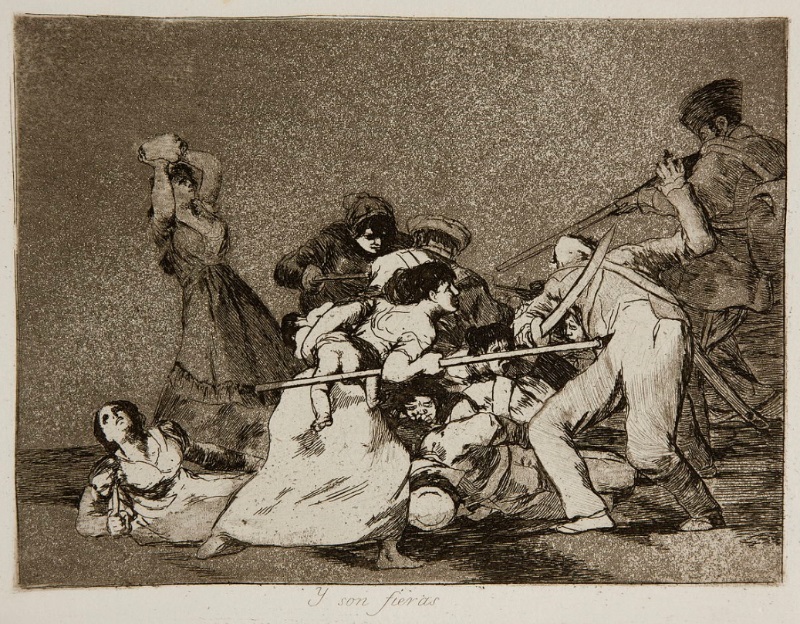
Detail: "And they too are fierce" from When I count, there are only you ... but when I look, there is only a shadow. Farideh Lashai. British Museum, London
Farideh's entire oeuvre is loaded with subtlety, including time lapses: the mere 2 seconds that each print is illuminated is long enough to have impact while still allowing us to blink and put the horror we are seeing into some kind of context. The beam illuminates the cruelty which then disappears into shadow while the spotlight continues on to the next scene. This less frenetic rhythm, this more intermittent repetition comes, perhaps, from Persia where the appearance and disappearance of history's most terrible moments forms part of its culture. In western cultures, our forced saturation in violent images by the media has anaesthetised our ability to take in the true horror of a car bomb in Kabul or the effect of shrapnel on a child's body, as happened in Manchester. Thanks to this distinct rhythm, Farideh re-educates our vision, makes us ask ourselves questions and insists on leaving us to ourselves, even when the light goes out: "Video meant a bridge to literature and offered me enormous scope for expressing myself. It brings something unexpected to my painting and creates a sensation of surprise. Also, when the video stops, the nature of the painting will have acquired a different meaning." And this sensation is so real that, after contemplating her work for a while, we walk to Goya's "Black Paintings" where the late Farideh's intentions are fulfilled. In "Fight To The Death With Clubs", our eyes don't just remain transfixed by the fight between two men, rather they travel down to the mud covering them up to their knees and the sky, ominous with clouds.
Among all her early travels, Farideh Lashai felt the need to be in Spain and pay a visit to the Royal Chapel of St Anthony of La Florida. This is what she wrote of it: "Goya's tomb was simple, seemly and sad - a rectangular slab of stone and a bunch of flowers beneath the dome of frescoes he himself painted. One of Franco's soldiers stood guard at the iron railings and I thought about who was resting in peace under that cold stone, about the man who was part of a revolution."
{youtube}PE8gx3om_SY|900|600{/youtube}
(Translated from the Spanish by Shauna Devlin)
Farideh Lashai
When I count, there are only you ... but when I look, there is only shadow
A work invited to the Prado Museum
Paseo del Prado
Curator: Ana Martínez de Aguilar
Until 10 September 2017
Farideh Lashai
Between the motion And the act Falls the Shadow
Edward Tyler Nahem Fine Art
Calle Sánchez Bustillo 7, Madrid
Curator: Paloma Martín Llopis
23 June - 13 July 2017
- Broken Images: Goya and Farideh Lashai - - Alejandra de Argos -
- Details
- Written by Marina Valcárcel
This may not be art criticism as such, coming as it does in the final days of an exhibition, but it may rather be the question: What will remain after its close? What mark will it leave behind? The Anselm Kiefer retrospective at the Pompidou Centre in Paris will end in a few weeks and all that will be left of the 150 monumental paintings and 40 glass display cases is the question: What happens after Kiefer? It will not be easy for the artistic panorama of the next few years to match the impact of this exhibition. The density of his ashy, cloudy paint remains suspended, living, floating above the Parisian skyline on the sixth floor of the museum. It would seem almost as if the walls of various galleries in the Pompidou have had to be specially reinforced to accommodate the sheer size of these colossal paintings.
|
Autor Colaborador: Marina Valcárcel
Licenciada en historia del Arte
|
 |
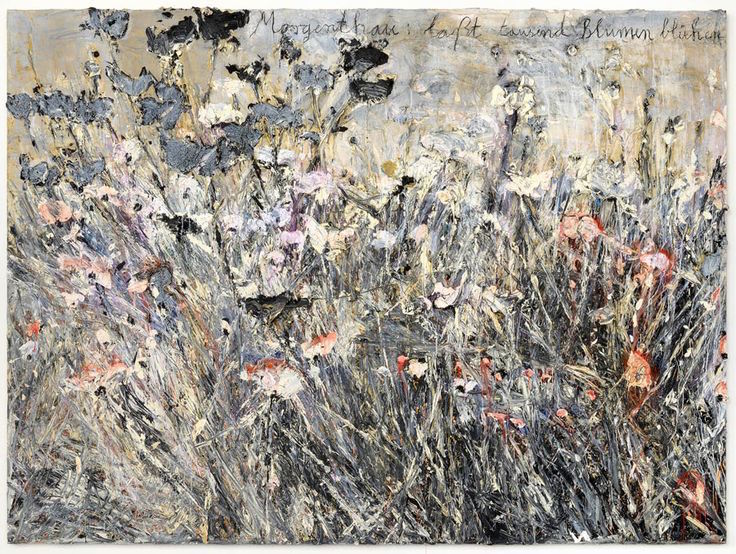
Der Morgenthau Plan (The Morgenthau Plan), 2014
This may not be art criticism as such, coming as it does in the final days of an exhibition, but it may rather be the question: What will remain after its close? What mark will it leave behind?
The Anselm Kiefer retrospective at the Pompidou Centre in Paris will end in a few weeks and all that will be left of the 150 monumental paintings and 40 glass display cases is the question: What happens after Kiefer? It will not be easy for the artistic panorama of the next few years to match the impact of this exhibition. The density of his ashy, cloudy paint remains suspended, living, floating above the Parisian skyline on the sixth floor of the museum.
It would seem almost as if the walls of various galleries in the Pompidou have had to be specially reinforced to accommodate the sheer size of these colossal paintings. Some are of the insides of claustrophobic, totalitarian architectures; some are of snow-covered, bloodstained forests; some are of serpent-strewn pathways named after battles such as Teutoburgo, Varus ... And then there are Kiefer's landscapes: arid, divvied up into motley wrinkles as if they were traintracks leading to cremation ovens, converging into a one-dimensional escape route towards a flattened horizon and a sky that doesn't exist. These are the denunciations of a German artist seeking to make some noise in a world of silence.
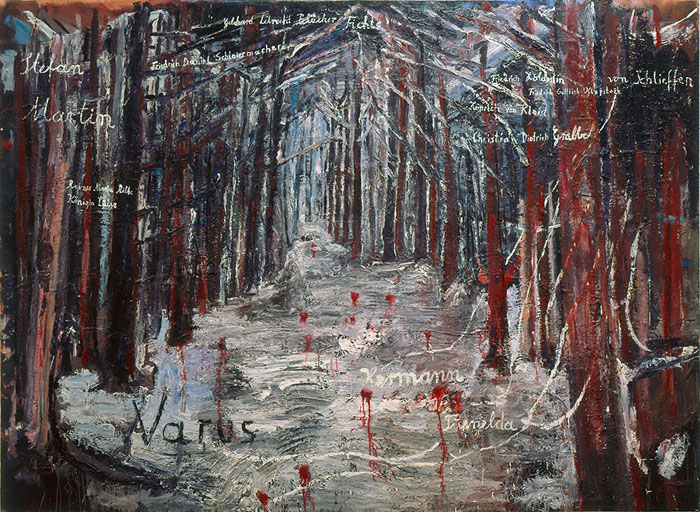
Varus, 1976
Anselm Kiefer was born in May 1945 in Donaueschingen, a part of the future Federal Republic of Germany, and belongs to that second generation of Germans who grew up without reference to or memories of the Nazi regime. Those were years in which the country's authorities anaesthetised the entire population in an attempt to avoid any sense of responsibility or culpability for the Holocaust and when a layer of charcoal was thrown over the whole of German tradition and its Nazi past to destroy any recollection thereof. Kiefer was born after Auschwitz but wants to live alongside Auschwitz. This is why, after 1970, his work becomes what Daniel Arasse calls "a theatre for memory": to rescue, restructure and represent German identity. From that moment on, Kiefer's mental imaginings become wholly dedicated to the creation of a contemporary version of historical painting.
At this moment, the Pompidou's white ceiling appears lower than is customary, drawn down and diminished by the sheer height of Kiefer's paintings and by the concrete flooring that makes the uniquely artificial light shine like steel. Even the gallery housing the glass display cases is somewhat suffocating, each one squeezed beside the next as if in a dusty old Natural Sciences museum. These object displays are the fruit of Kiefer's accumulation of what he calls the catacombs of his Barjac studio: objects waiting to be converted into messages: pieces of clay, spools of charred film, old typewriters, fossils, twisted lamps and dried flowers. Nothing is thrown away, every material thing has a life, everything is recycled within or into another painting or another sculpture.

Saturn-Zeit (The Time Of Saturn), 2015
Kiefer excites our sensorial curiosity. And he does so with his pictorial technique: from his choice of materials to the stratification in layer upon layer of them onto a picture painted over what could be any length of time: "My paintings might be compared with the Talmud, with their commentary on commentary, their sedimentation on siltation. If one made a hole in the canvas, the whole history of the painting would be visible, vertically", says Kiefer, who challenges us through the materials, the colours and the condition of his paintings. From the 90's onwards, his works, encrusted with paint, have been much more than just an image. They are, rather, a journey over deep, rough and uneven terrain that invite us and our puzzled senses to familiarise ourselves with them, to touch the unknown, to feel, to scratch, to smell them almost.
Anselm Kiefer's paintings are not easily approachable, the spectator having to put distance between himself and them by moving away and thereby finding himself looking at completely different dimensions. Kiefer's works since 1980 have aquired titanic proportions perhaps because history is a construction that can't easily be assimilated. All of Kiefer's art impacts us. And this initial impact is to do with the world of sensations, not just that of dimensions. It is an arbitrary division of aesthetic philosophy, Kiefer belonging more to the realm of the sublime than the realm of beauty. Kiefer's work seizes the spectator, obliges her to steel herself, infects her with anxiety and perplexity but also with curiosity. In this sense, Kiefer puts up the same barriers as a German Romantic would. We feel the immensity and vastness of Wagner's Ring Cycle and its tragedy. It also takes us towards solitude, doubt and the same question asked by Caspar David Friedrich's subject, the man wearing a black dress-coat leaning on his walking stick, his back to us facing faraway mountains: The Wanderer Above A Sea Of Fog (1818).
Anselm Kiefer is an all-round artist: painter, sculptor and creator of installation spaces but also, and especially, he is an artisan: blacksmith, miner, carpinter and a landscaper artist living with an intense interior discourse: "My biography is the biography of Germany" he says, but it is also the history of the Jews, Shoah, Kabbala, The Song of Songs, Germanic myths, alchemy and the cosmic vision of Robert Fludd: every heavenly body has its counterpart in a flower. And books, his library: Heidegger, Walter Benjamin, Hölderlin, then Ingeborg Bachmann and after her, Paul Celan. And after Paul Celan, more Paul Celan. Paul Celan has been deeply imbedded in Kiefer's paintings since 1980 . The latter is a German painter who takes on his country's past by unearthing the Holocaust and who always wanted to be a poet, the former a renowned Jewish-Romanian poet of the latter half of the 20th century who chose to write the poetry that burned inside him in German, the language of his tormentors.
Is it possible to write poetry after Auschwitz? asks Theodor Adorno. Perhaps there's only room for silence. But if one chooses the route of not being silent, if one wants to continue to denounce in German, it then becomes necessary to refound that language. For this reason, Celan uses language somewhat secretively. And so, from this union between painter and poet, come entire verses written in Kiefer's looping, joined-up letters, words emerging from black skies to live on in the paintings. And their titles: "For Paul Celan: Ash Flower", because flowers and Celan come together many times in Kiefer's work.
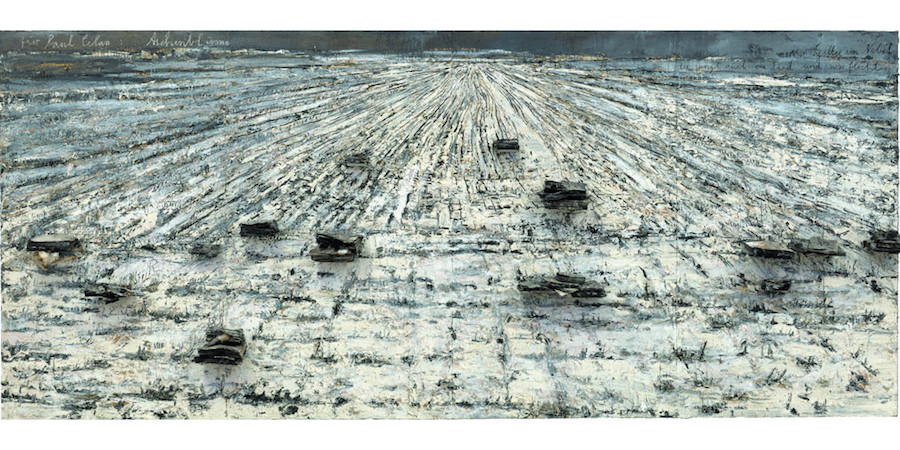
Für Paul Celan: Aschenblume (For Paul Celan: Ash Flower), 2006
"Your Golden Hair, Margarethe" is a 1981 painting inspired by Celan's poem "Death Fugue". Kiefer paints, sticks and scratches strange flower-like blades of straw that emerge from the black ground like rays of light tipped with a pink flame. These are Margarethe, representing the German nation with her long golden hair and Shulamith with her burnt, ashen hair representing the Jewish people. These icons of Celan's poetry are represented also in the materials used: straw, ash, hair, sand ... As if the written words themselves had melted onto the surface of the paint.
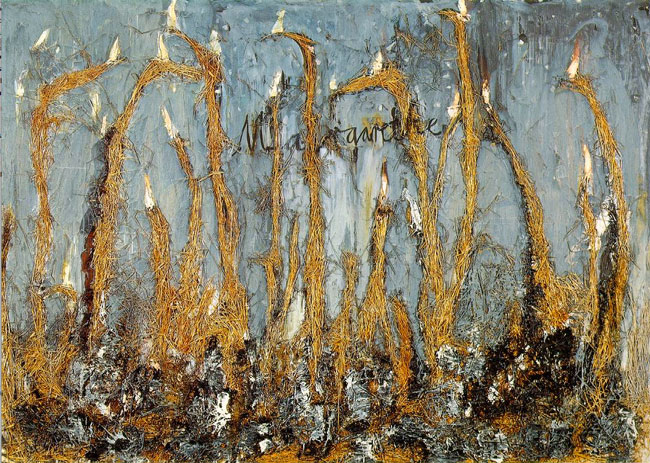
Your Golden Hair, Margarethe, 1981
We continue on through the Pompidou. Suddenly and unexpectedly, we enter a different room altogether that is bright, light and flooded with sun and colour. And, we think, cheeriness. There are only four large-scale paintings of flowers here. Why is Kiefer painting flowers? Why has he started planting field-fulls of sunflowers in Barjac where he has his studio? Why are sunflowers gradually invading his paintings and sculptures? Kiefer is once again using painting to challenge and question history. Towards 2010, Kiefer turns to something that happened in the final days of the Second World War ~ The Morgenthau Plan. In order to prevent a post-war Germany from developing a programme of heavy industry and to thwart the threat of her re-arming, the US Secretary of the Treasury, Henry Morgenenthau, proposed a radical plan to the international authorities which involved converting Germany into a primarily agricultural and pastoral country. Kiefer imagined the enforcement of this plan by painting pictures bulging with carpets of colourful blooms, lets himself get carried away by their beauty, covers his canvases in thick layers of acrylic paint from which emerge soft multi-hued shapes which remind us of Kiefer's devotion to Van Gogh's painting. He called it "The Morgenthau Plan".
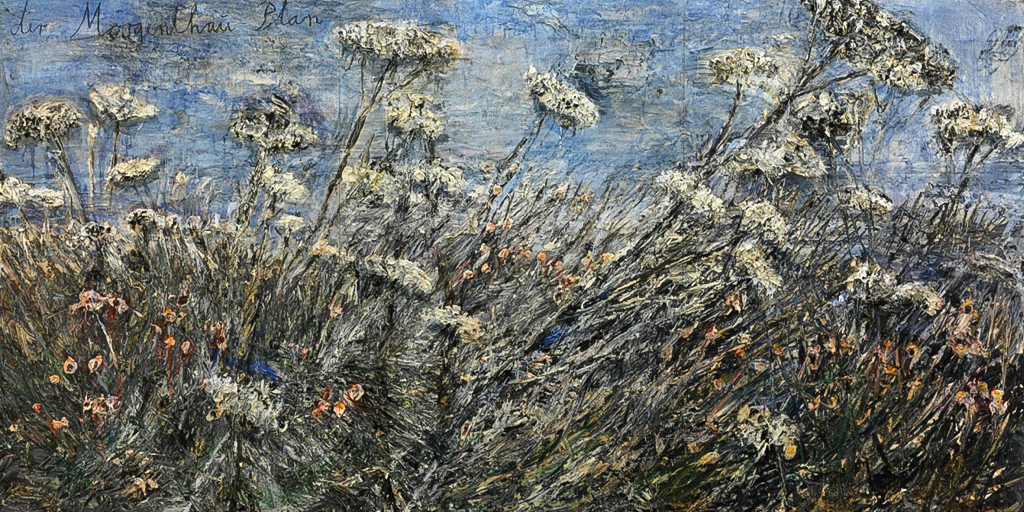
Der Morgenthau Plan (The Morgenthau Plan), 2014.
On the opposite wall is "Lilith" (1987 - 1990). Since his visit to Israel in 1984, Kiefer's paintings have been heavily influenced by the Kabbalah (developed in the 16th century by Isaac Louria), the Bible and various rabbinic texts. Lilith was Adam's first wife before Eve in Jewish mythology and she personifies envy, jealousy and the desire for revenge. She is the serpent in the Garden of Eden. The painting, inspired by Kiefer's visit to Sao Paulo in Brazil, shows an apocalyptical city covered in ash. In the centre hangs a long lock of black hair that symbolizes Lilith. The rest of the painting appears studded with dried poppy stalks that leap out of the canvas at us. Again and again there is reference to Paul Celan, one of whose earliest poetry collections was entitled "Poppy and Memory", poppies being the symbol of both forgetting and remembrance.

Lilith, 1987-1990.
According to the Scriptures, all who are buried in Israeli soil return to life. The scholars of Judaism say that the land of Israel has the power to expiate, to forgive sins. Paul Celan committed suicide aged 48 by drowning in the Seine, Paris. He is buried in the unassuming Thiais cementery on the outskirts of Paris. His plain tombstone is grey, identical to most of the others but covered in little stones. This is how Jews leave a sign that they have visited their dead loved ones. Because flowers belong to life.
(Translated from the Spanish by Shauna Devlin)
- Anselm Kiefer, las flores y la poesía de Paul Celan - - Página principal: Alejandra de Argos -
- Details
- Written by Marina Valcárcel
As we approach the High Altar of St Paul's Cathedral in London, sunlight floods through the two great windows on either side. The glass is neither stained nor tinted, just crystal clear. We walk slowly here, amazed by the pomp and colossal size of Wren's cathedral, perhaps a little disoriented by its resemblance to St Peter's Basilica in the Vatican City with its baldachin, its Solomon's Temple-like columns, its sheer dimensions and its profusion of marble. But here there is an electricity distinct from that of Rome. Nelson is buried beneath our feet, as is Wellington. There are flags from old military campaigns, memorials and, more importantly, there is contemporary art. Staggering present-day pieces that speak to us of current conflicts and originate from all over the world.
|
Author: Marina Valcárcel
Art Historian
|
 |

As we approach the High Altar of St Paul's Cathedral in London, sunlight floods through the two great windows on either side. The glass is neither stained nor tinted, just crystal clear. We walk slowly here, amazed by the pomp and colossal size of Wren's cathedral, perhaps a little disoriented by its resemblance to St Peter's Basilica in the Vatican City with its baldachin, its Solomon's Temple-like columns, its sheer dimensions and its profusion of marble. But here there is an electricity distinct from that of Rome. Nelson is buried beneath our feet, as is Wellington. There are flags from old military campaigns, memorials and, more importantly, there is contemporary art. Staggering present-day pieces that speak to us of current conflicts and originate from all over the world. There is a Virgin Mary in a refugee camp by the graffiti artist CBloxx, two gigantic white crosses by the Indian artist Gerry Judah hanging from the central nave ... Different languages in a powerful crossover between the Baroque and the ultra-contemporary. My companion and I think of Spain. We expect something with a bit more rage to it, something more challenging, something to be overcome. We think of Burgos, Leon, Toledo and others, with their cathedral choir stalls, their altar railings. Bill Viola began working in Gothic churches to reflect their sound, that opaque silence that scales their pillars to the heavens ...
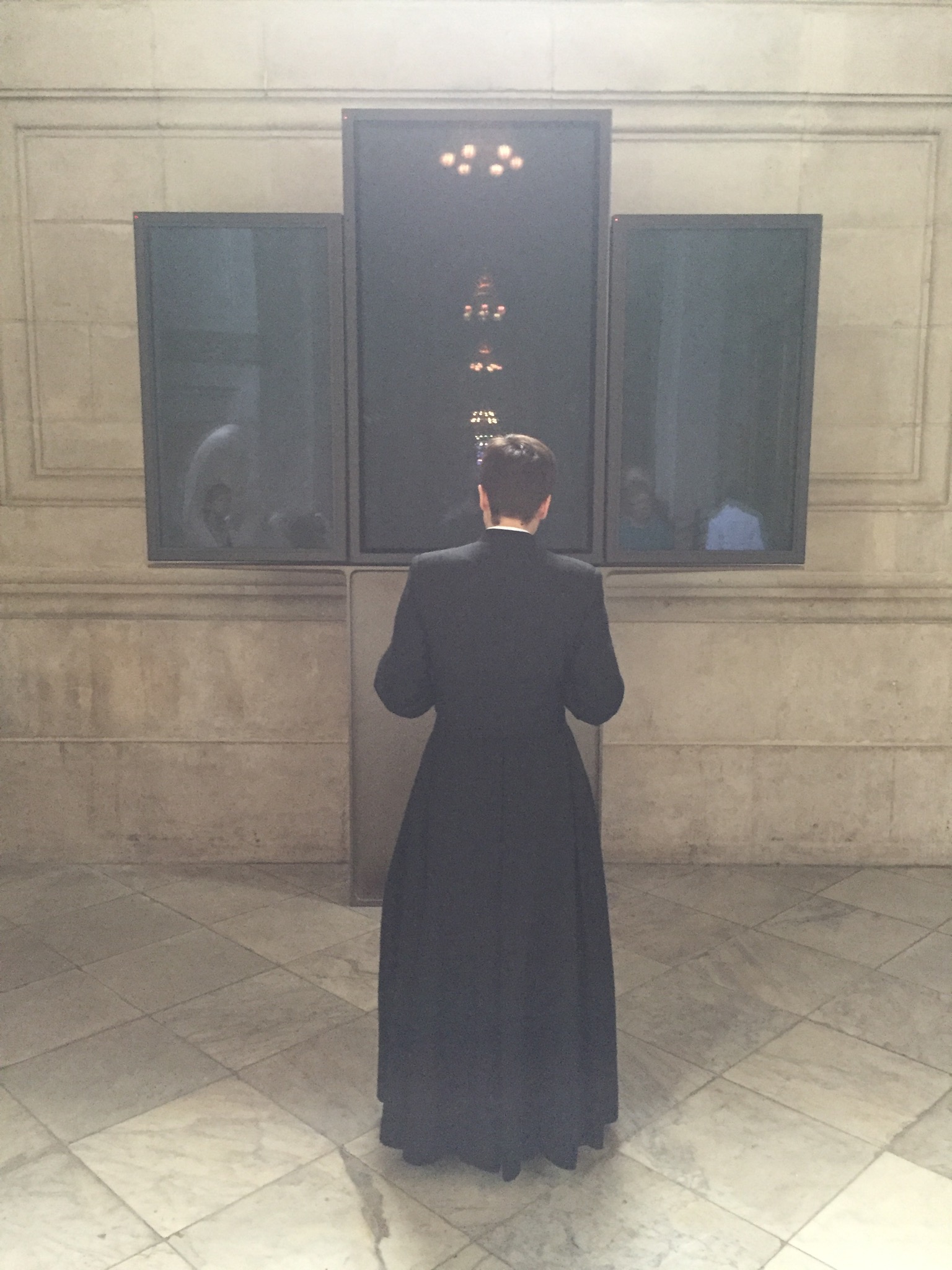
We wander further and pass Henry Moore's sculpture "Mother and Child: Hood" in the apse. A little further and we find ourselves in the North Quire aisle to the left of the High Altar. There, where our cultural references would lead us to expect a Baroque altarpiece with painted, gold-leafed wooden figures, we find instead a nun of quite masculine appearance, cassock, dog collar and boyish haircut. She is pointing at three plasma screens with a remote control. And then begins a fascinating experience for Christians like us, in the year 2016, in an Anglican cathedral rebuilt after the Great Fire of London in 1666. This modern-day triptych lights up to show a shaven-headed, dark-skinned woman of indeterminate race. She wears a saffron-coloured tunic whose colours call to mind the Buddhist monks of Cambodia. Her right breast is bared as she breastfeeds the baby boy in her lap. Behind her, the speeded-up lights of the Los Angeles horizon change from morning pinks, to evening , to nightfall over an extended length of time while she, all slow motion, doesn't take her gaze off ours. The scene is emotionally powerful, wrapped in the mystery between modernity and intemporality, between the most advanced technology and the purity of the miracle of sustaining life by means of warmth and a mother's milk.

FRAGMENT OF LIFE
The screen then fragments, much like a pradella of reliefs on a Baroque altar, into a series of other scenes depicting Mary's life. There is the visit to her cousin Elizabeth, arriving alone through meadows and embracing another pregnant woman, dead fish on a riverbank, a weeping deer filmed in black and white, blackberry bushes teeming with thorns. Seven minutes shot from the Zion National Park in Utah to the desert surrounding the Salton Sea in California and places in between.
The final scene is, however, one of classic beauty. A Michaelangelo-like Pietà with Mary this time light-skinned, in a blue veil, rosy complexioned and holding the marble-like body of her son, just crucified, in her lap. She doesn't cry. She just looks back at us, sorrow-stricken and unable to understand the physical reality before her eyes. She then looks down at her son's body, raises his lifeless hand and kisses it. The scene ends with the screen turning black.
We attempt to think of this level of restraint in any other examples in painting or cinema. We also trawl our literary references til we come up with those comments of Colm Tóibín's on writing his "The Testament of Mary": “I lived in the epicentre of Mary's pain. I would never like to return there." But the gaze of Viola's Mary is unlike anything else. We are too used to the fixed image of paintings and photographs or the moving image of film. In these recordings, as in all of Viola's works that lack narrative discourse, the slow camera maximises our chances of really seeing and feeling the sentiment expressed.
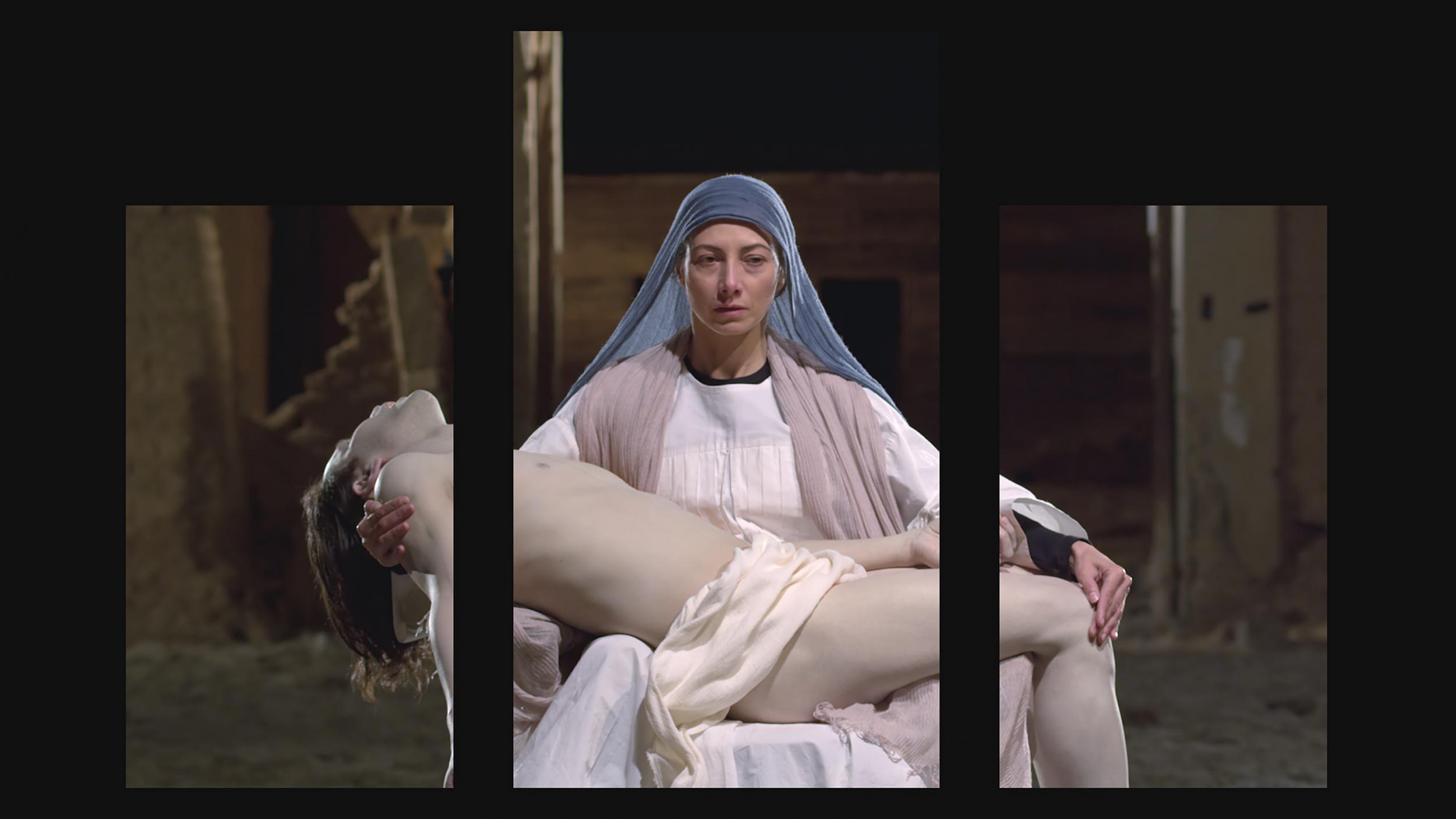
Mary. Bill Viola. St Paul's Cathedral, London
MARY: HOW THE WORK COME ABOUT
Bill Viola's works can be found in some of the world's greatest museums but this is the first time in 2,000 years that a sacred moving image, on video, has ever substituted painting or sculpture in a grand temple of Christianity.
Bill Viola (New York, 1951) took 13 years to conclude these two works for St Paul's. It was in May 2014 that the first video, Martyrs, arrived in the South Quire aisle, to the right of the High Altar, Mary being installed to the left on the 8th of September 2016. Both videos are on permanent loan from the Tate Modern and his wife, Kira Perov, collaborated on both.
Viola admits to long-term 'artist's block' about the figure of Mary and confesses: "She nearly killed us." The theme of both installations was suggested by the cathedral itself: "Until the middle of the 20th century, there were other paintings in the Quires based on Mary and the martyrs. They intimated to me that it wasn't necessary to repeat those themes but, effectively, they were setting me a challenge given that the fundamental thing about them is - for what reason and for whom would you be willing to lay down your life. And that is a devastating question."
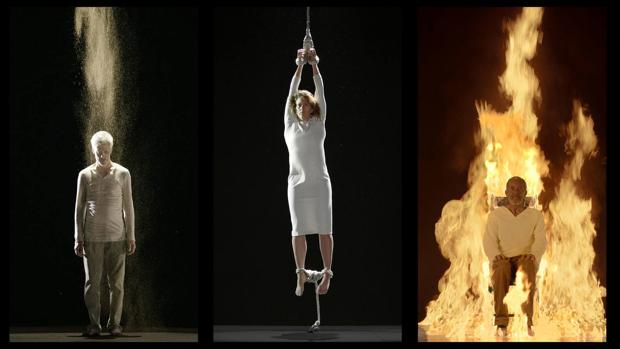
Bill Viola believes that there is a universal chain that links human beings: his parents continue to live inside him and he will continue to live inside his son after his death. From a very young age, he has felt drawn to Buddhism and its vision of the world, the idea of eternal rebirth - a principle rather more complex than the life - death - resurrection cycle of Christianity.
In all of Viola's work, silence reigns. It is as if each of the four elements that saturate his characters come straight from the noise in the depths of the universe. The silence in his videos is the equivalent of those areas left deliberately blank by painters, the ones we have to fill in ourselves with our own imaginations or emotions. It is precisely there, in that emptiness, that one finds the greatest of painters, musicians and poets. What Viola aims to do with his videos is to sculpt time: extend it, stretch it, slow it down, wind it in on itself in order to show us all its lines, shapes and ellipses. Somewhat similar to the practice of meditation, fixing the present moment, concentrating one's gaze so as to delve deeper into one's perception of a subject. And channelling the internal question: "What do I see?"
The artist transforms his camera into a second eye to teach us how to look at things the way he believes we should, namely, through introspection and seeing beyond external appearances. He invites us to share in the journey he himself has been on for forty years, one pertaining to three fundamental, metaphysical questions: Who am I? Where am I? Where am I going? Not to look for answers per se but simply to confront the question. He sums it up as: "The men of antiquity called them the mysteries. There are no answers to life or death. I think mystery is the most important aspect of my work. That moment when we open a door and close it without knowing where we're going. To be lost is among the most important things."
Viola is a 'painter' who invented a new palette of technological, numerical colours and created moving pictures that adhere to a new understanding of art. It is a crossover with the great masters of old - Giotto, Bosch, Pontormo or Goya from whom he takes not just themes but also an aesthetic. Nevertheless, far from being a link that prolongs the chain of art, he explains: "I'm not interested in appropriating these images. Rather, it's a case of penetrating into their interior, bringing them to life, inhabiting them, feeling them breathe. What interests me is their spiritual dimension, not their visual form."

Left: Pietà, Tomaso Masolino da Pinicale (1383-1447). Right: Emergence, Bill Viola (2002)
THE APPEARANCE OF ZEN
When Viola was studying at the The Getty Institute in 1998, the painting that he couldn't stop looking at was Dieric Bouts' (1445) Annunciation: "I fell in love with its austerity and zen-like appearance. The Annunciation is one of those unique moments when, through the figures of the Archangel Gabriel and the Virgin Mary, some news is transmitted before words, before language is spoken. The intimate knowledge by which a woman knows she is with child has nothing to do with verbalization. The conversation that is about to be held in this painting is of another dimension. That is its magic - the silence, the stillness ... all of it comes from a very profound place" he says.
But Viola also focuses on the aesthetic language of the classics and transcends it: "In this picture, I would point out the ambiguity of Mary's hands - raised, her palms open and facing each other. One doesn't know if this is in order to receive or to then close as a sign of prayer. The Archangel, however, has his index finger raised. This language of the hands is charged with symbolic meaning. Many of Christ's gestures, for instance joining his thumb and index finger together as a blessing, are also made by Buddhas. In the Hindu tradition, every hand gesture has a very specific meaning."

Annunciation (1445) Dieric Bouts
"I was born at the same time as video." Bill Viola identifies as being of the second generation of artists who use video, a generation that benefits directly from the discoveries of the first. He has experimented with this technique since the 70's when he was a student at the College of Visual and Performing Arts of Siracuse University, New York, one of the first centres to specialise in the technique. It was there that he observed the work of its pioneers and was assistant to Nam June Paik.
In one of his first videos, Reflecting Pool (1977-79), he records a man - himself - divebombing naked into a pool, his body suspended mid-air above the water by the camera, gradually fading into the substance of the image itself while the leaves on the trees in the background and the reflections on the water's surface continue to move. Reflecting Pool is probably based on personal experience. As a child, he fell out of a boat and almost drowned. Then almost unconscious, he now recalls feeling a total completeness and seeing images of extraordinary beauty. Since then, he has never been able to forget the spectacle of sunlight piercing the water while he was sinking in the lake. Neither has he ever been able to portray the incident in a direct way. However, his oeuvre is full of allusions to it, be they subtle and sweet or more violent immersions: births, baptisms, death. For Bill Viola, water represents each of the stages of life and is also the nucleus of his reflections on death.

A BRIDGE OVER THE THAMES
Staying with the water theme, we leave St Paul's and immediately sense the nearness of both the river Thames and that other "cathedral" - the Tate Modern on the opposite bank, separated from each other, or rather joined, by the Millenium Bridge. It is almost as if Foster, its architect, had stretched its wings to enable communication between the two great bridges of our culture - religion and art. We continue over the bridge and on towards the Tate's Turbine Hall. The single central chimney rises like a counterpoint to the cathedral's dome. Likewise, the perforated dark brick latticework standing out against the glowing inner lights of Herzog & de Meuron's new facade creates a dialogue and complements Wren's solemn white colonnade. We step out into the mildly humid fresh air and onto the bridge again, seagulls flying overhead, all the while remembering the inscription on William Blake's Memorial in the crypt at St Paul's: "Hold infinity in the palm of your hand / And Eternity in an hour".
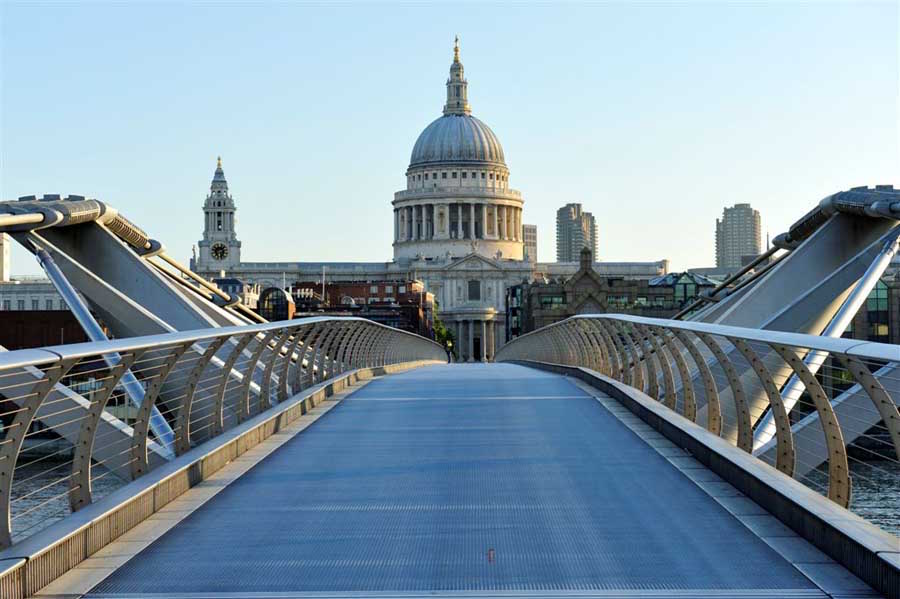
(Translated from the Spanish by Shauna Devlin)
- Bill Viola: "Mary" at St Paul's Cathedral - - Alejandra de Argos -



